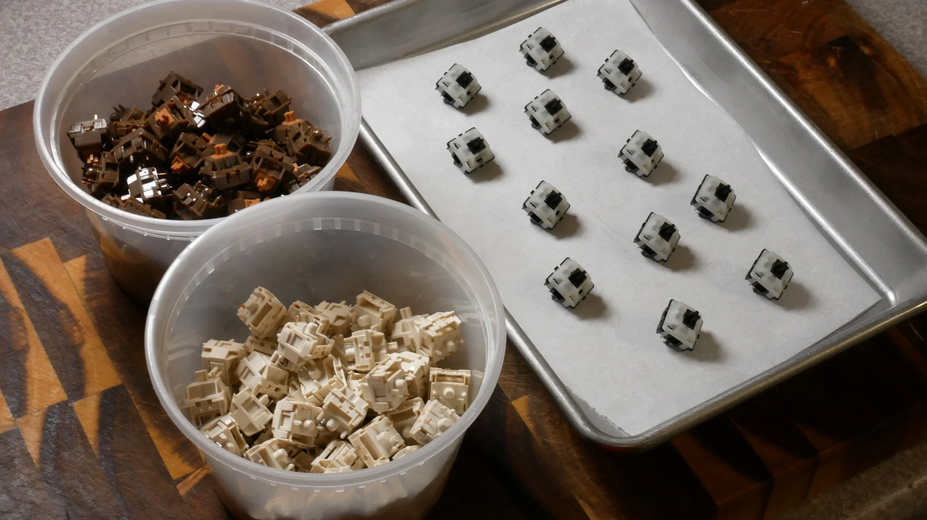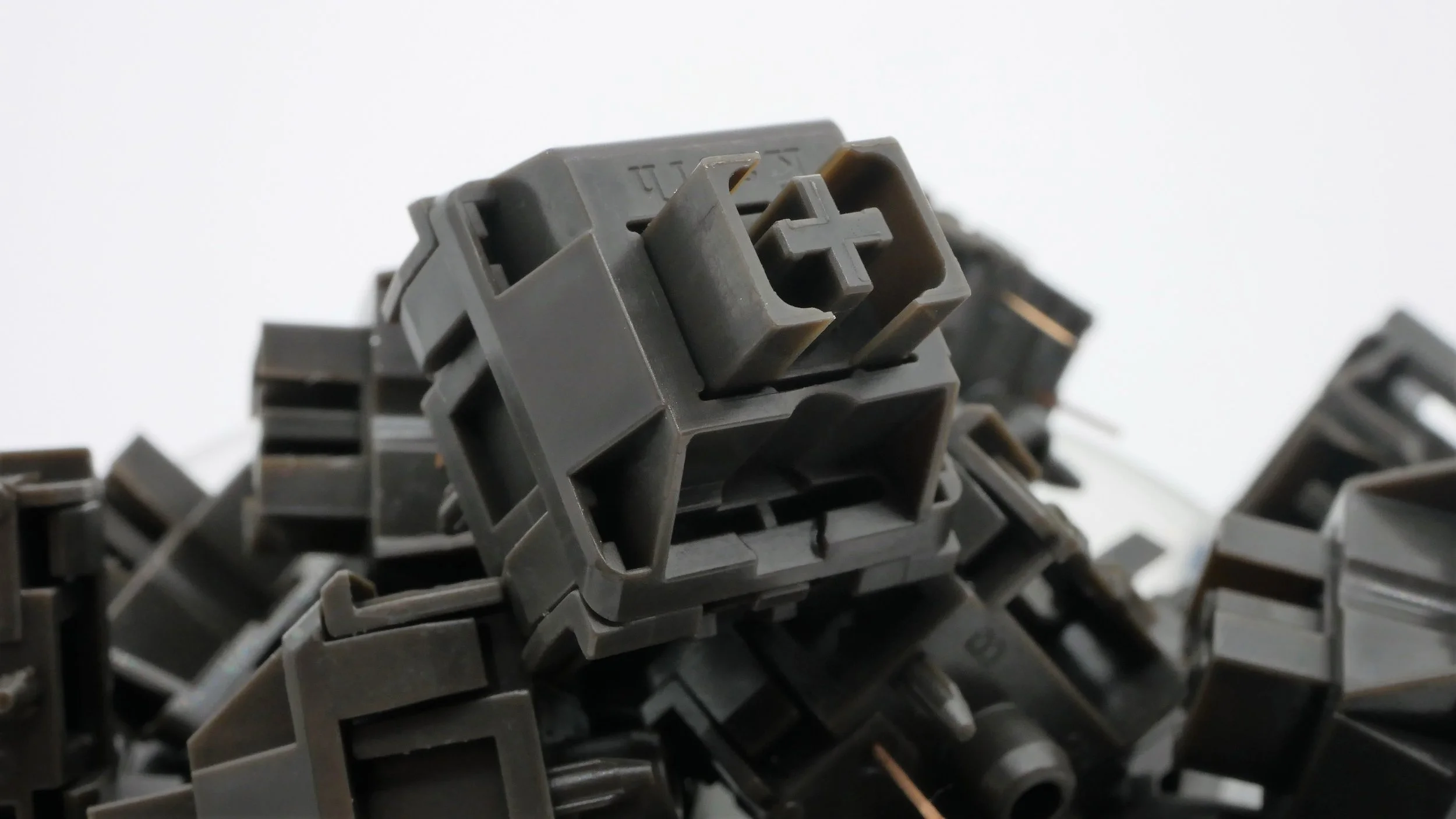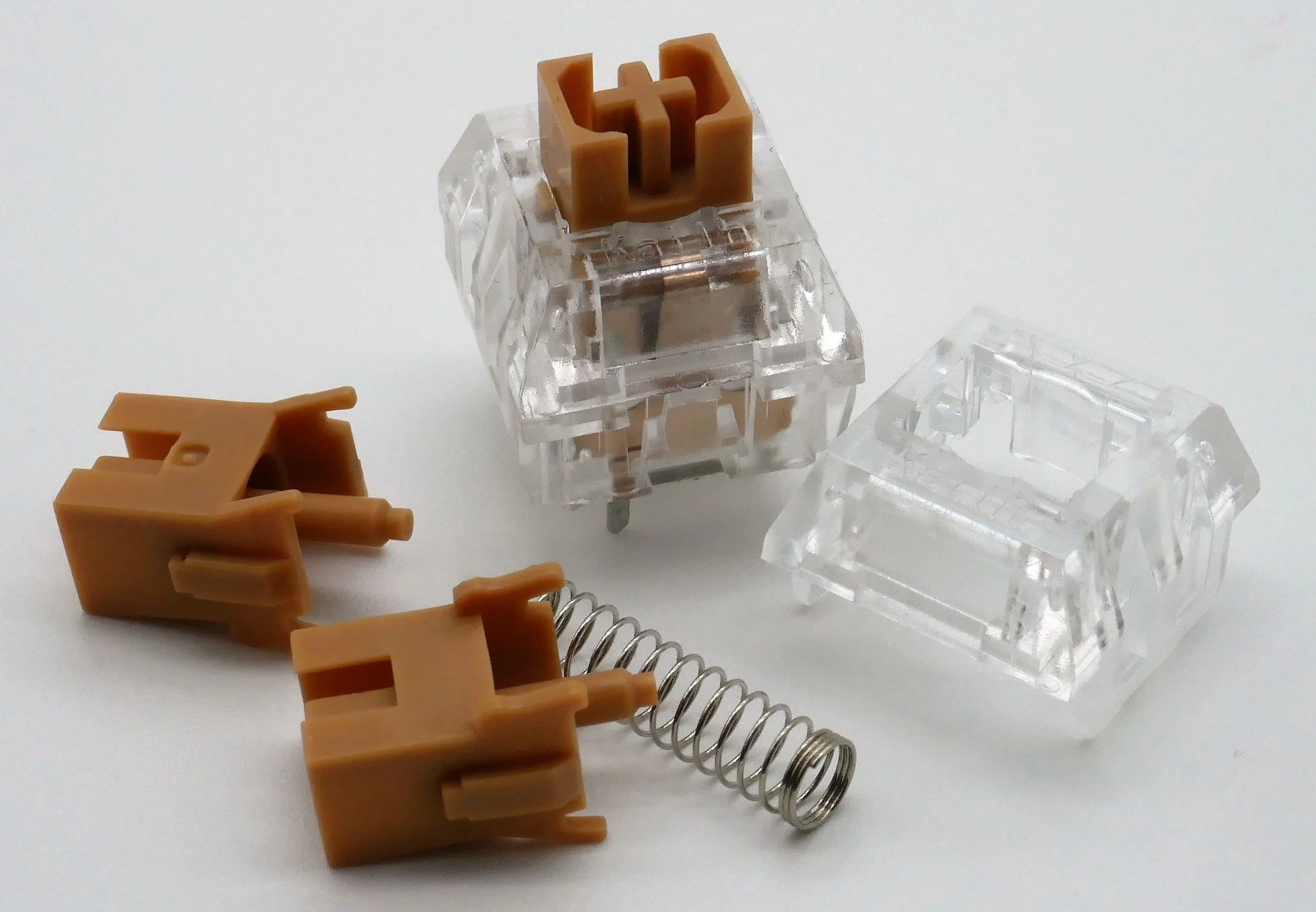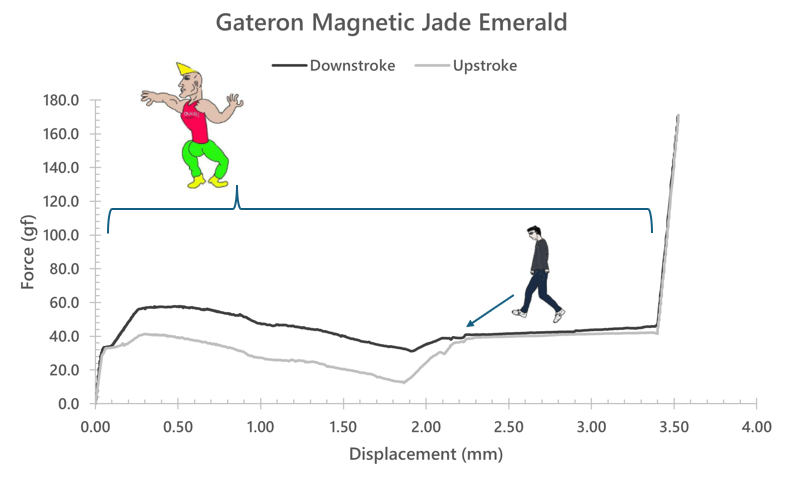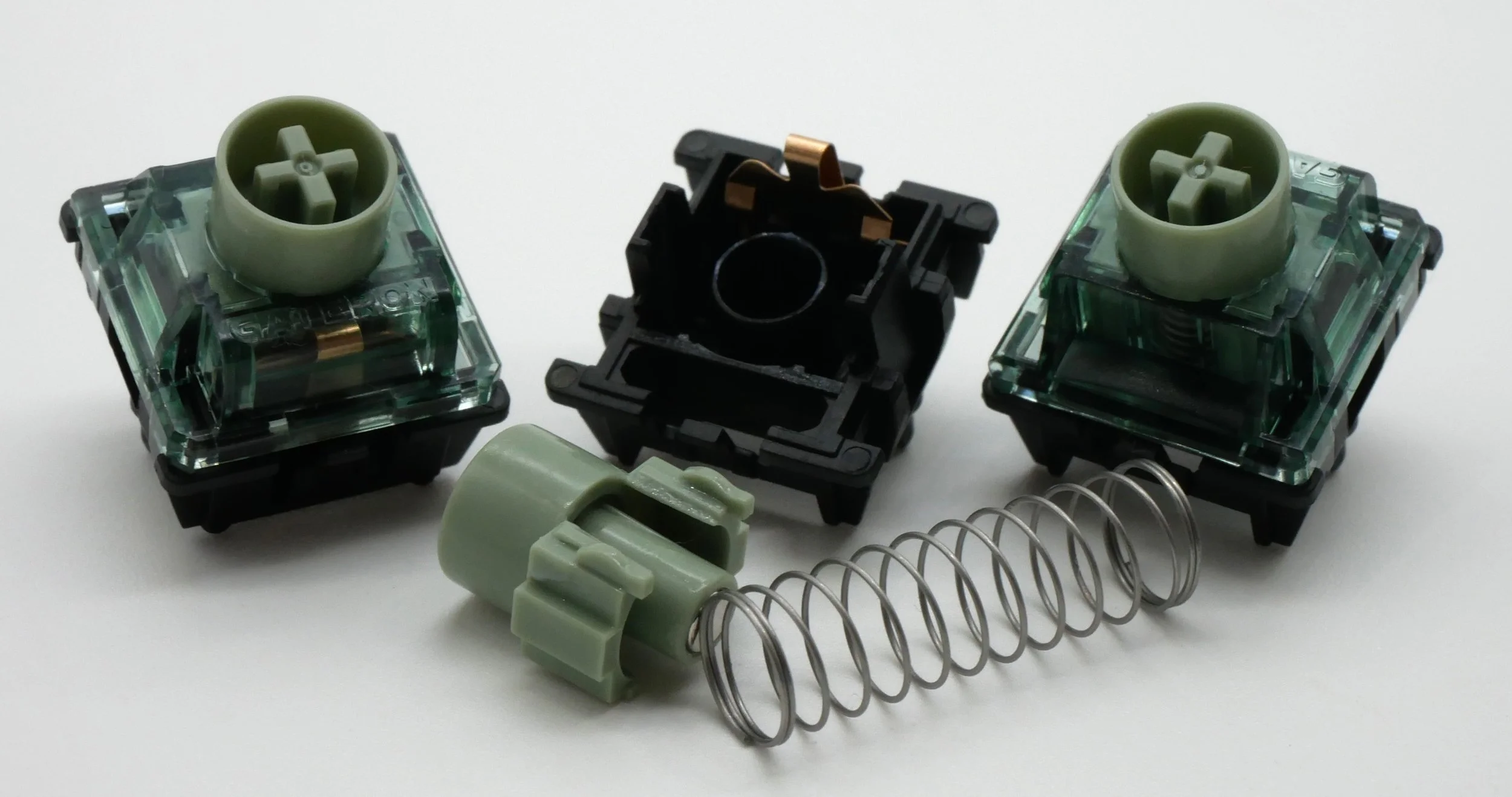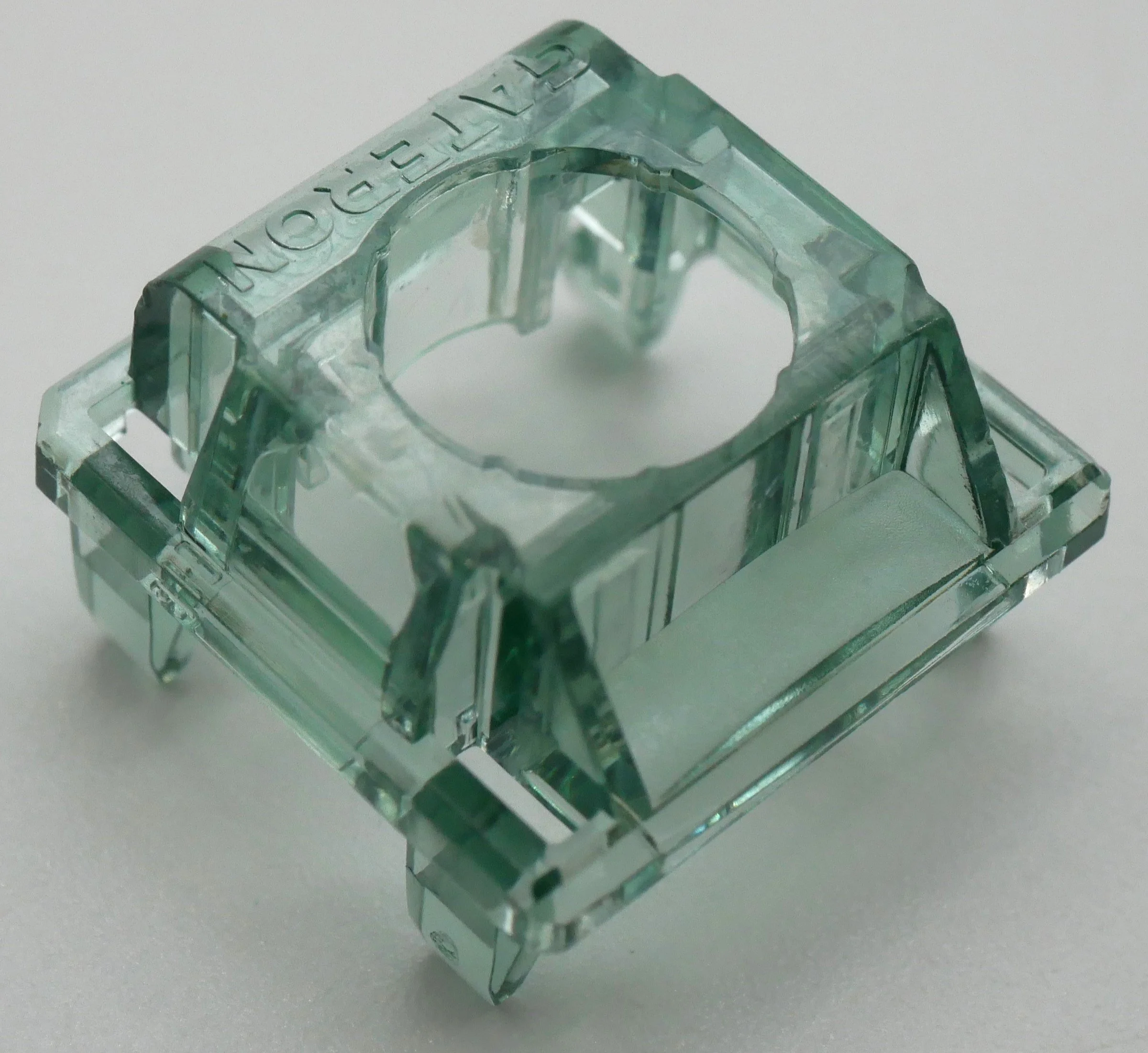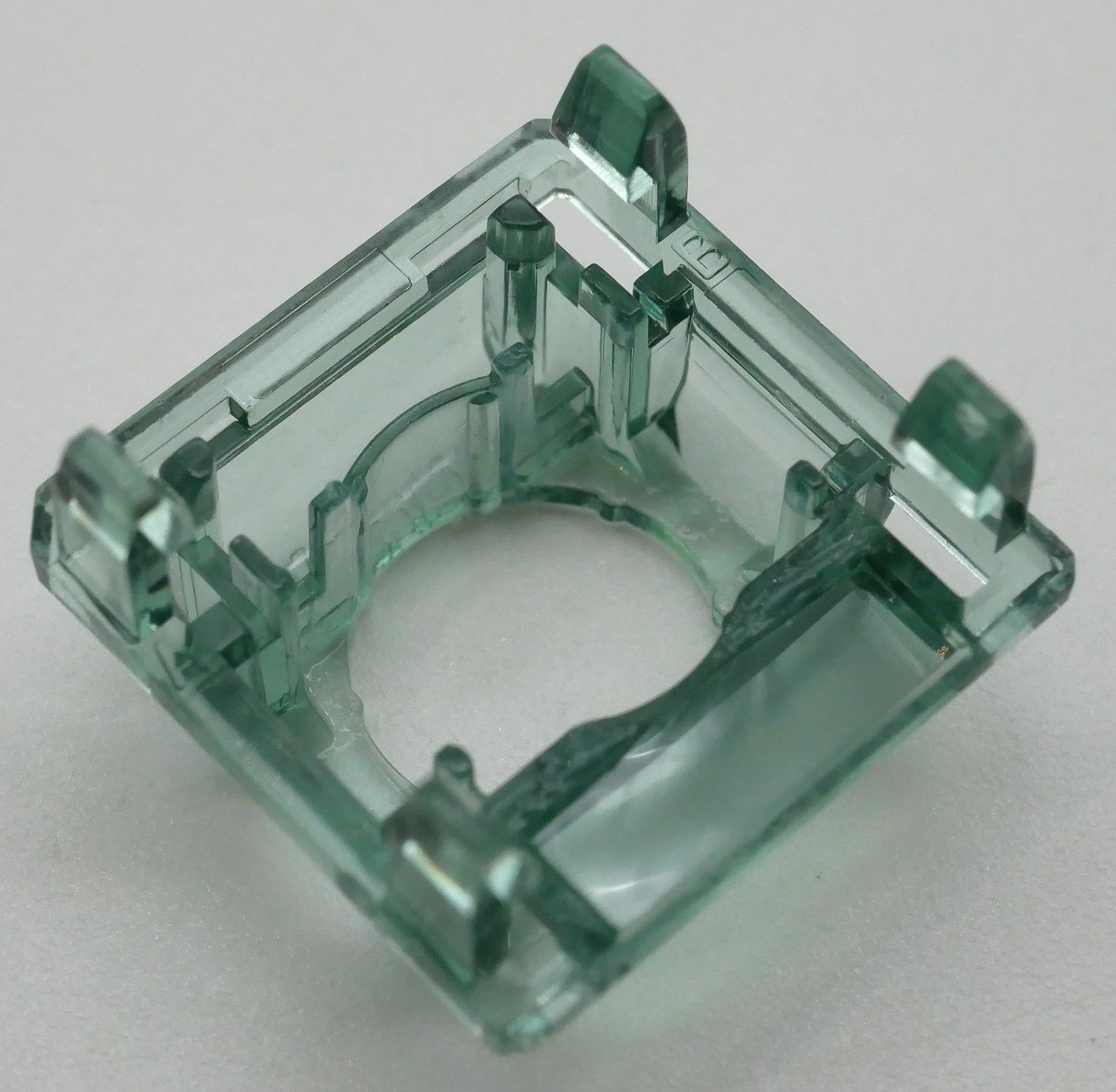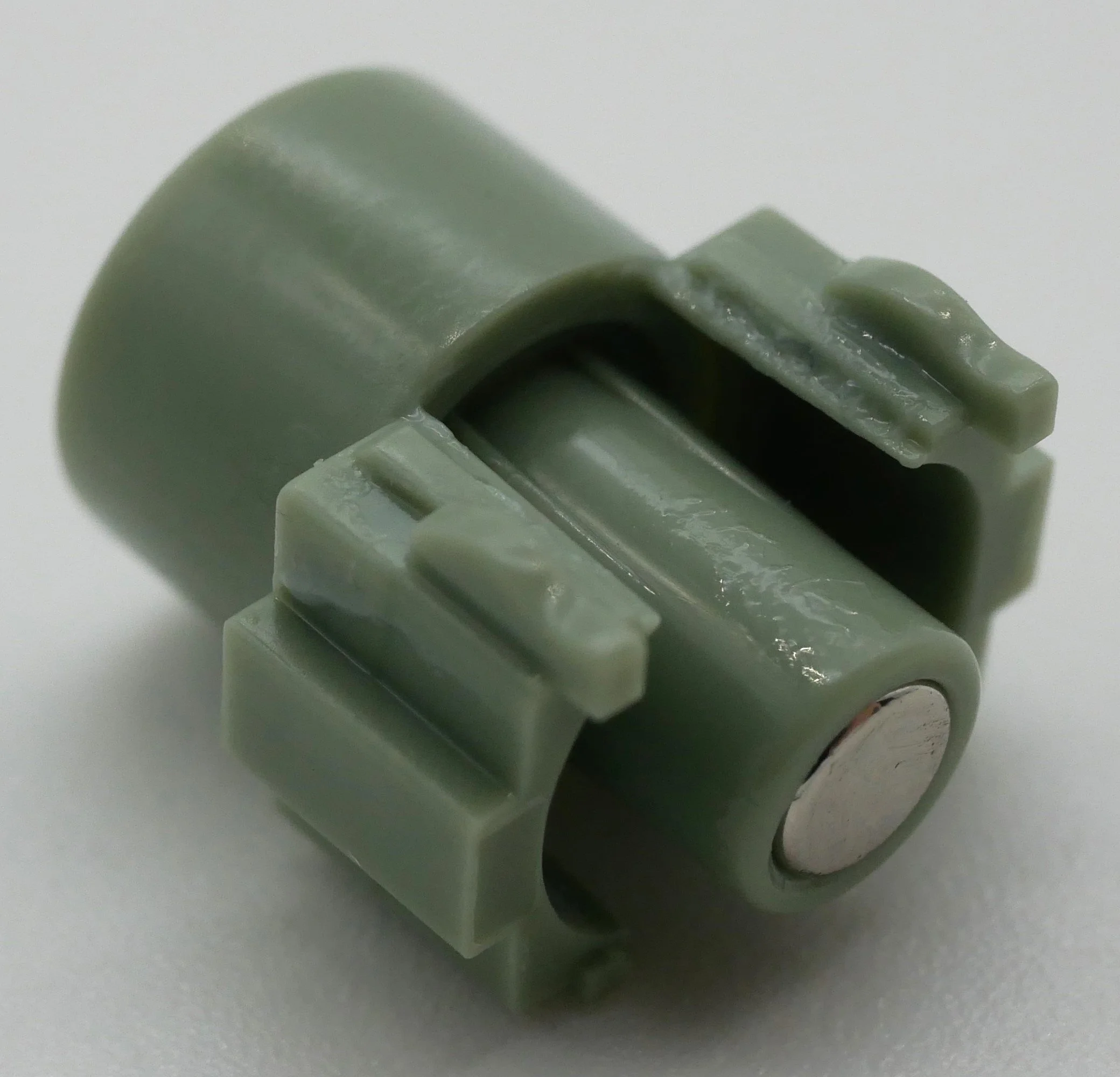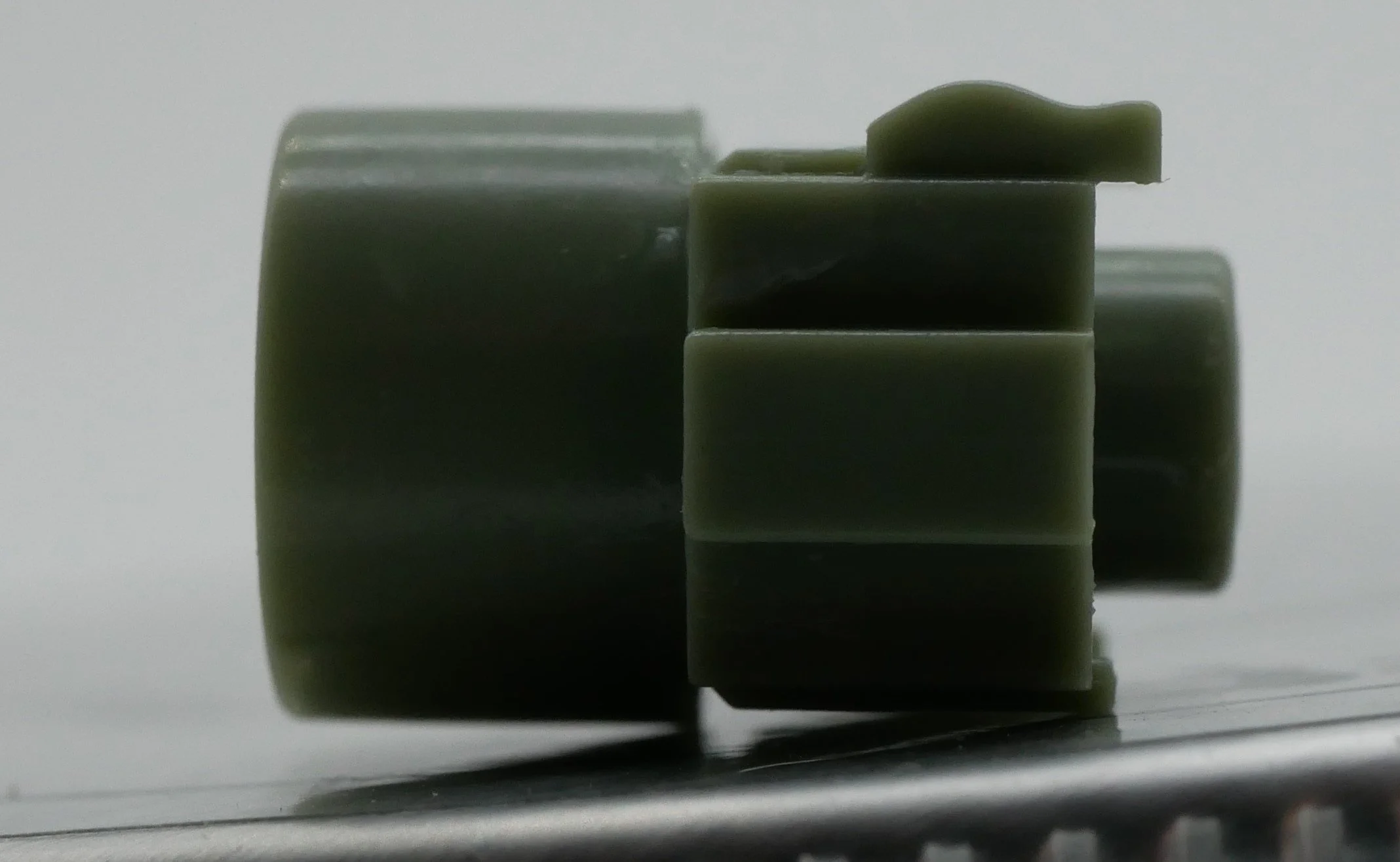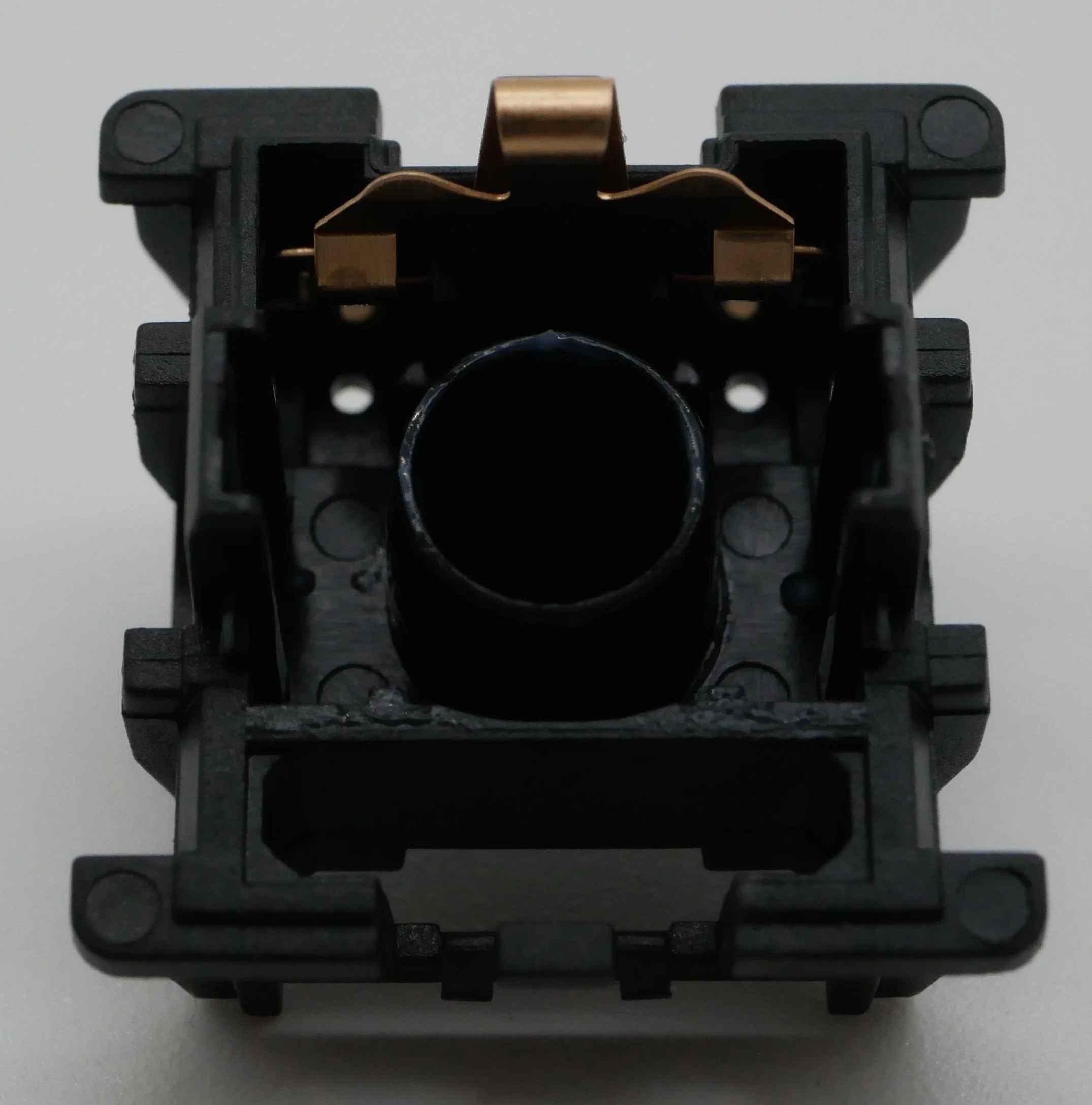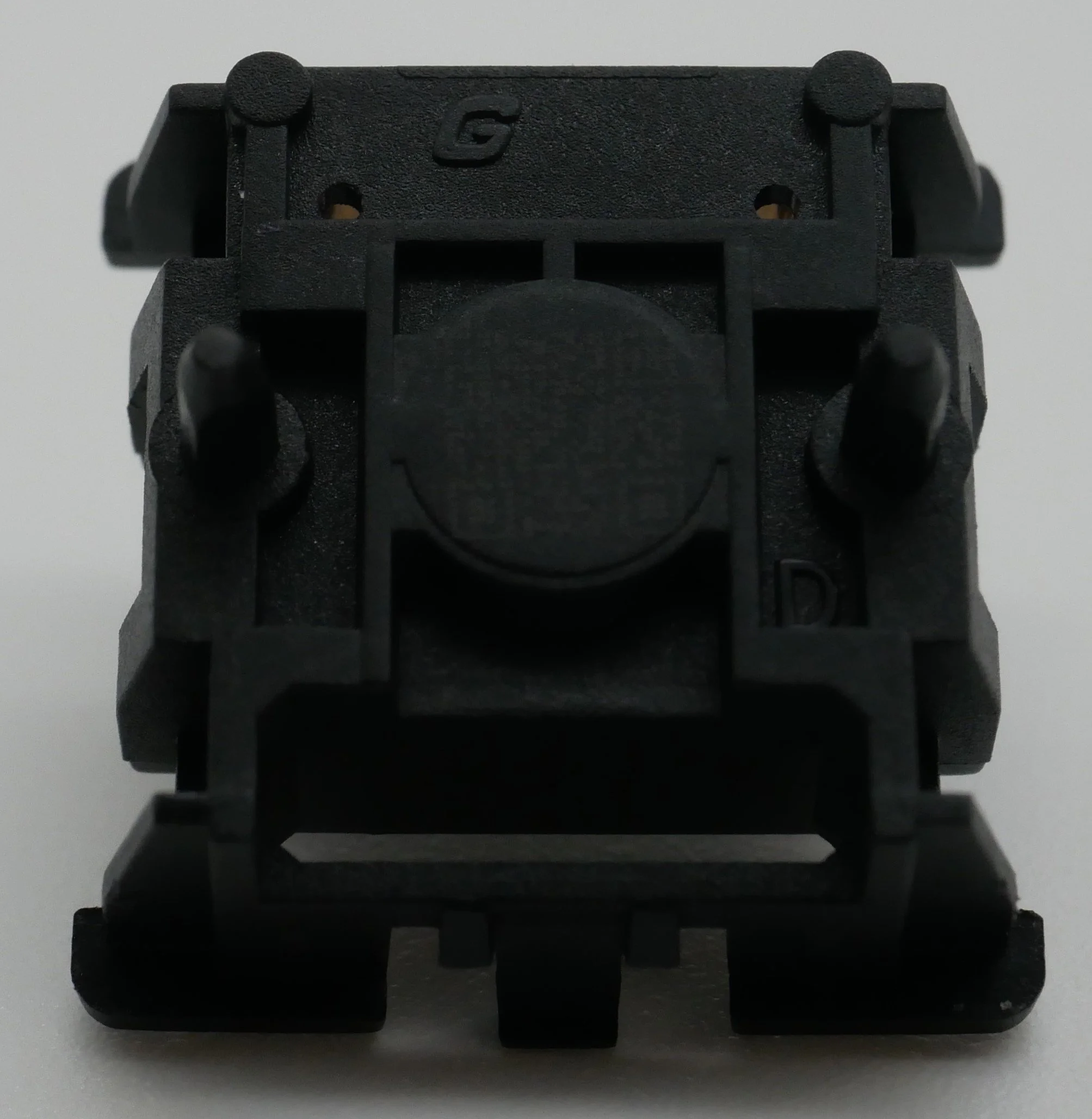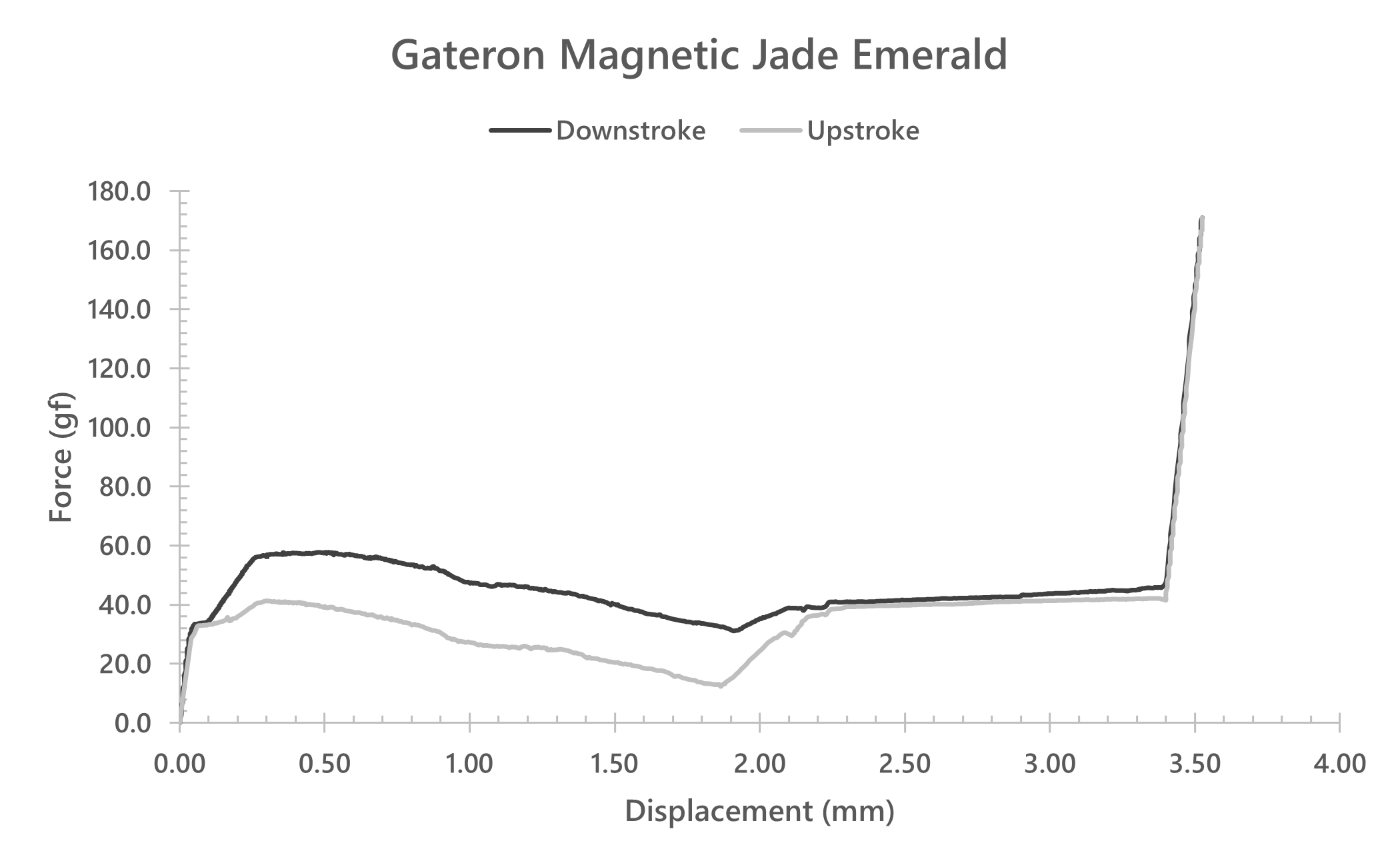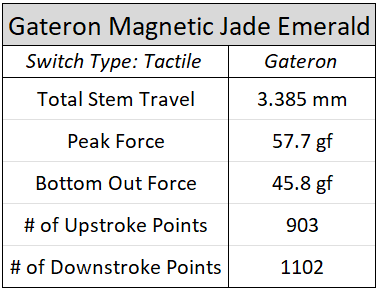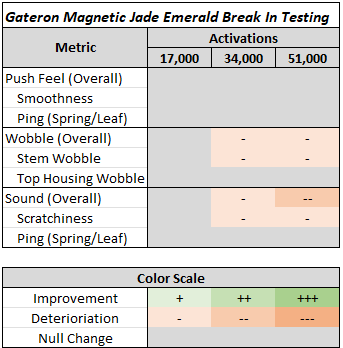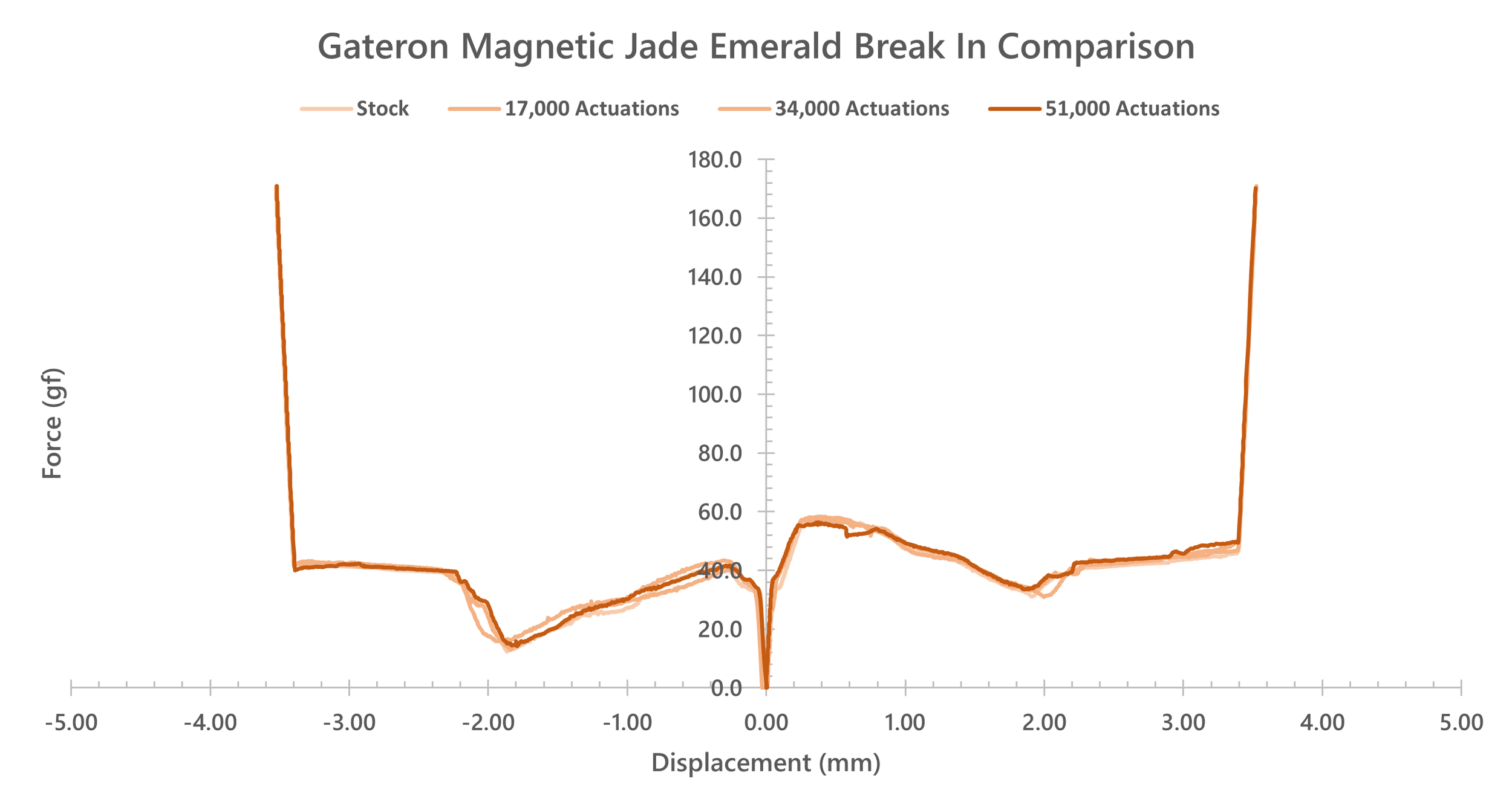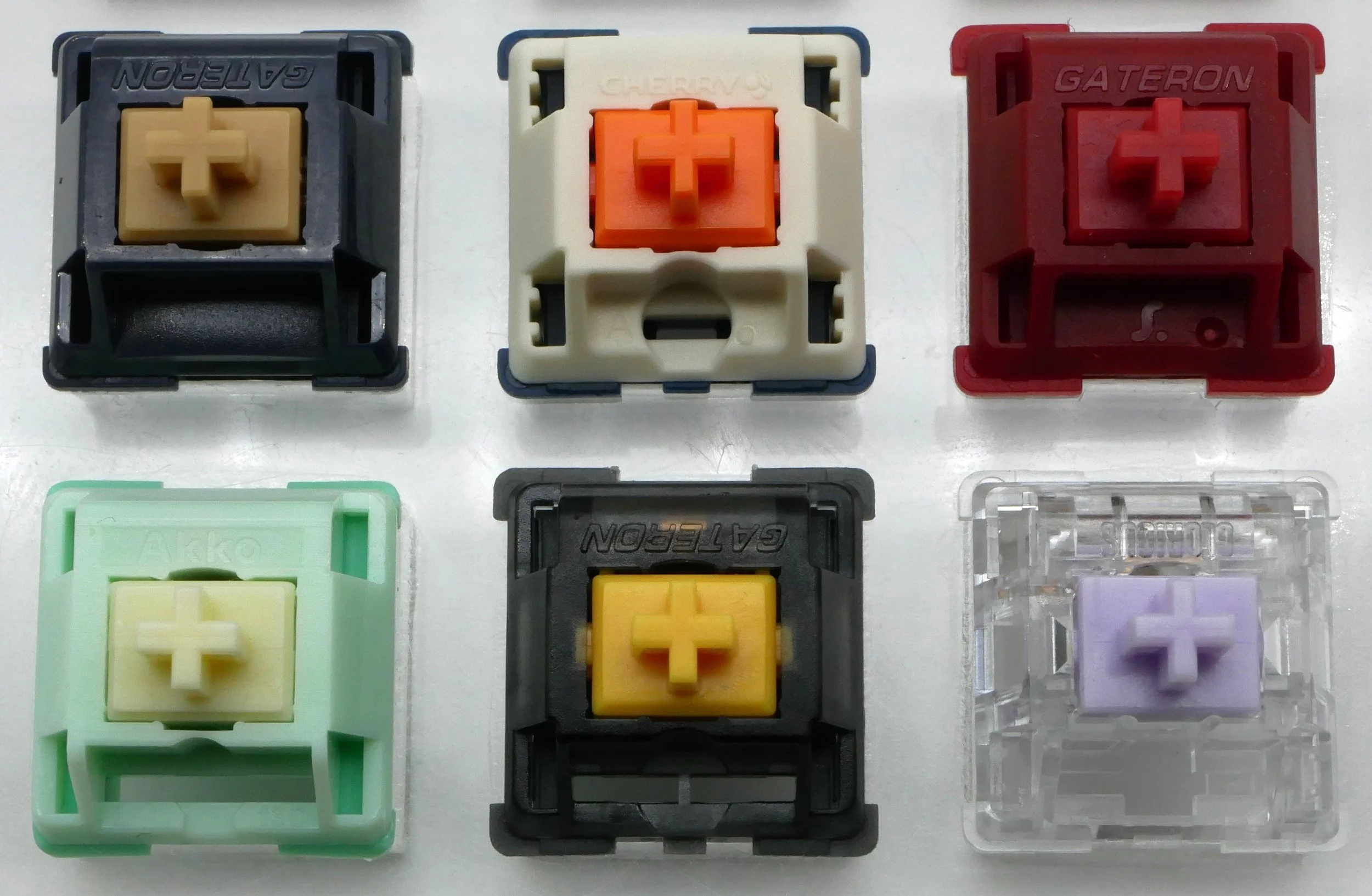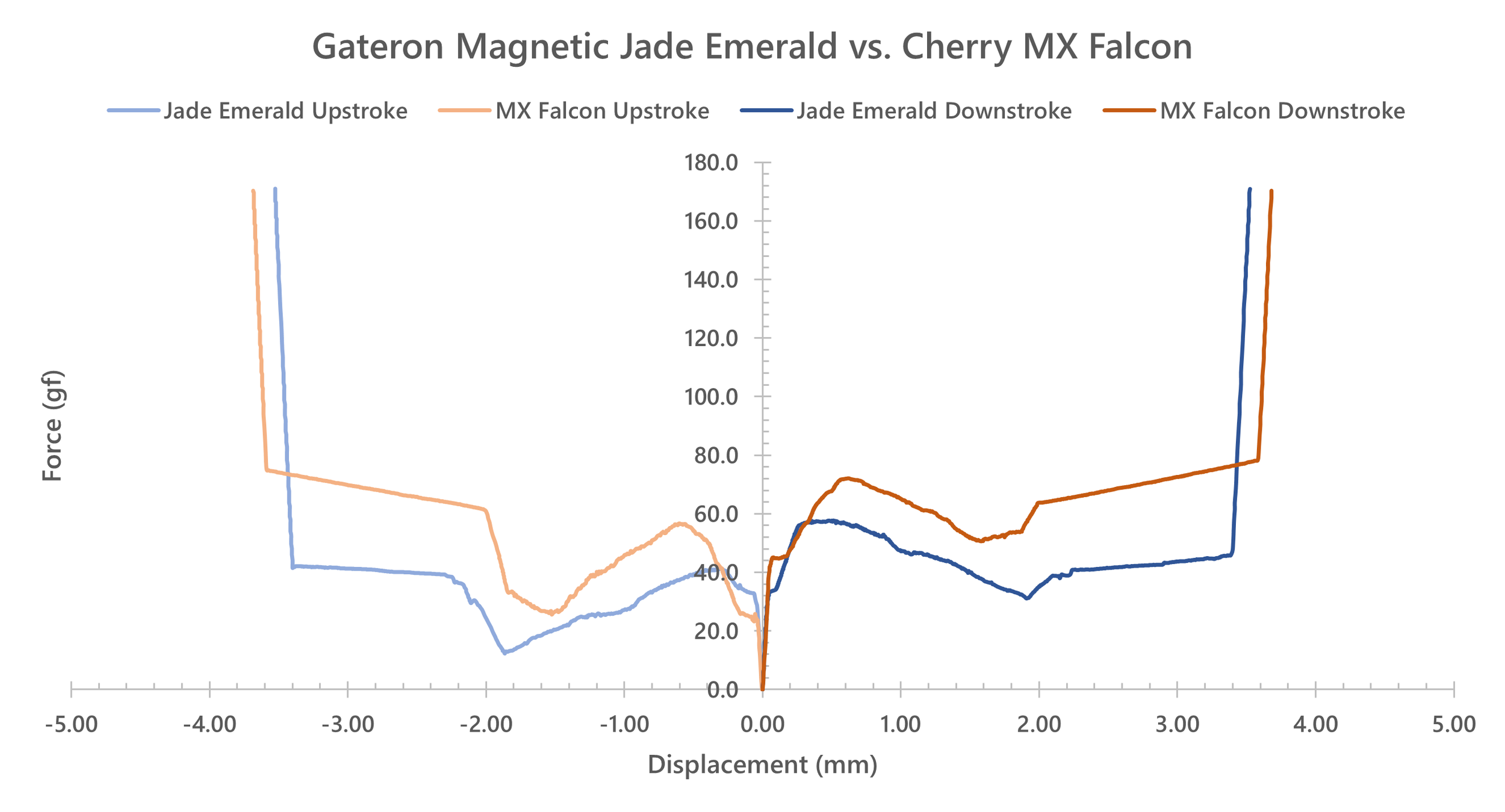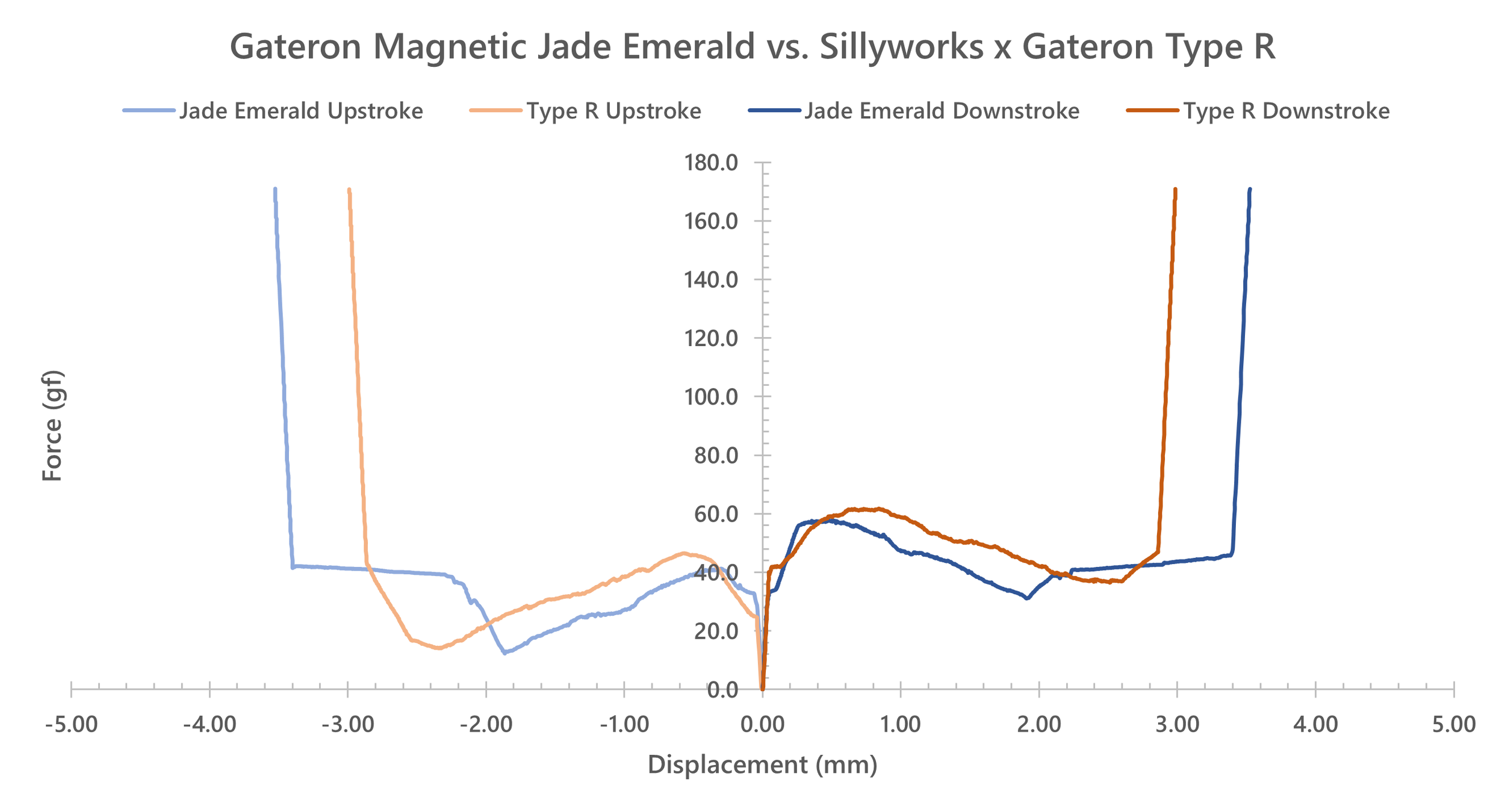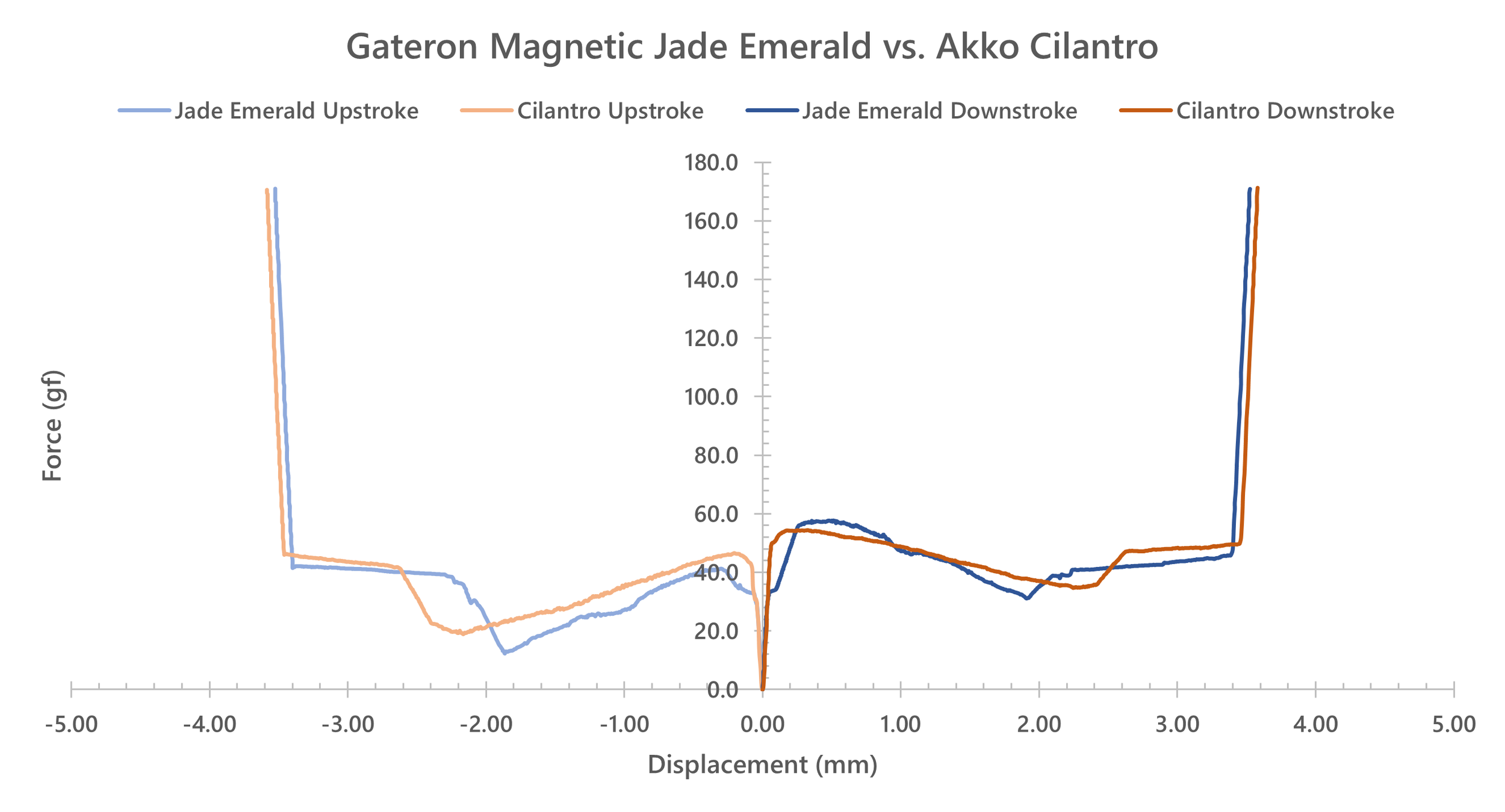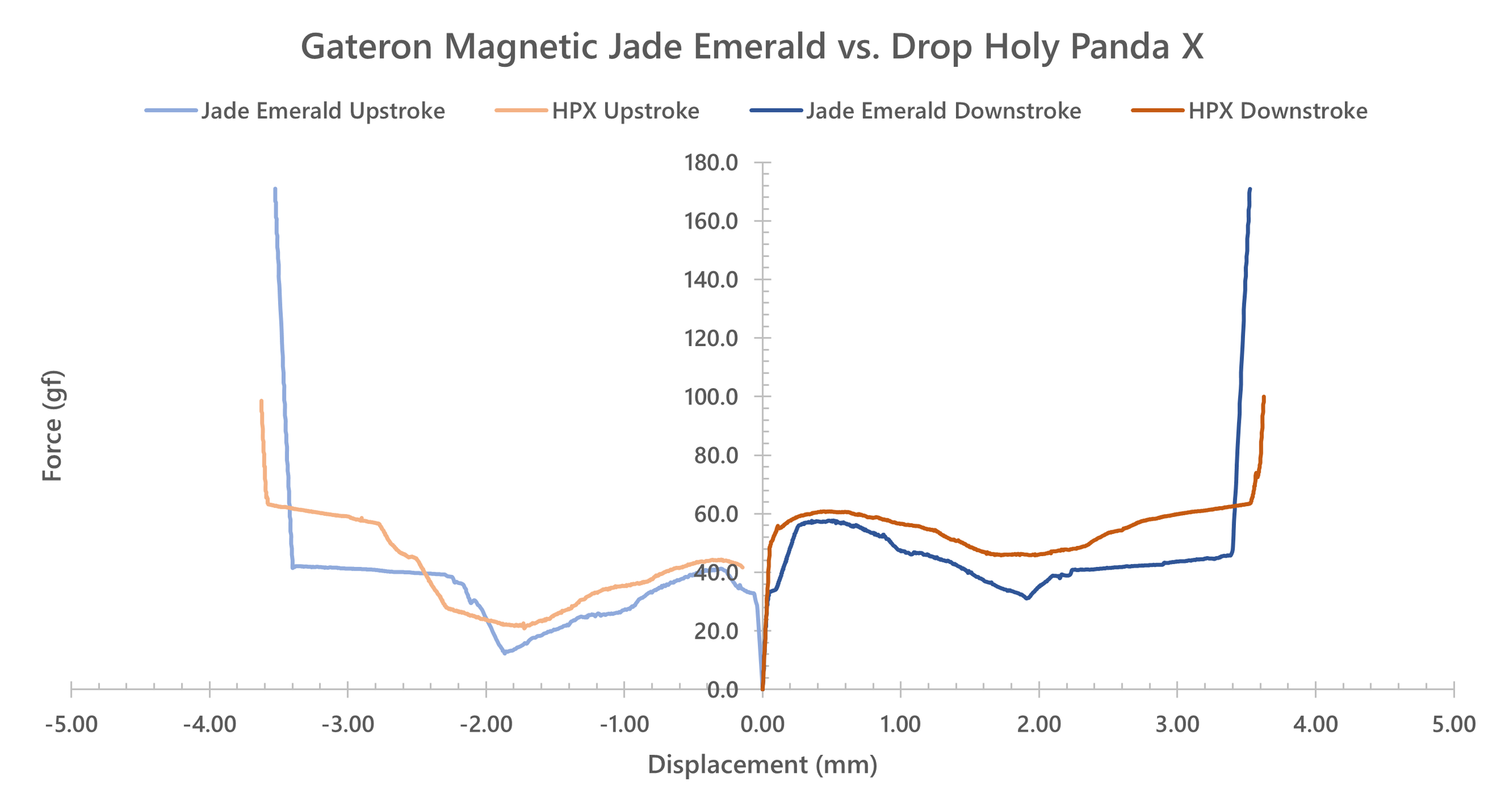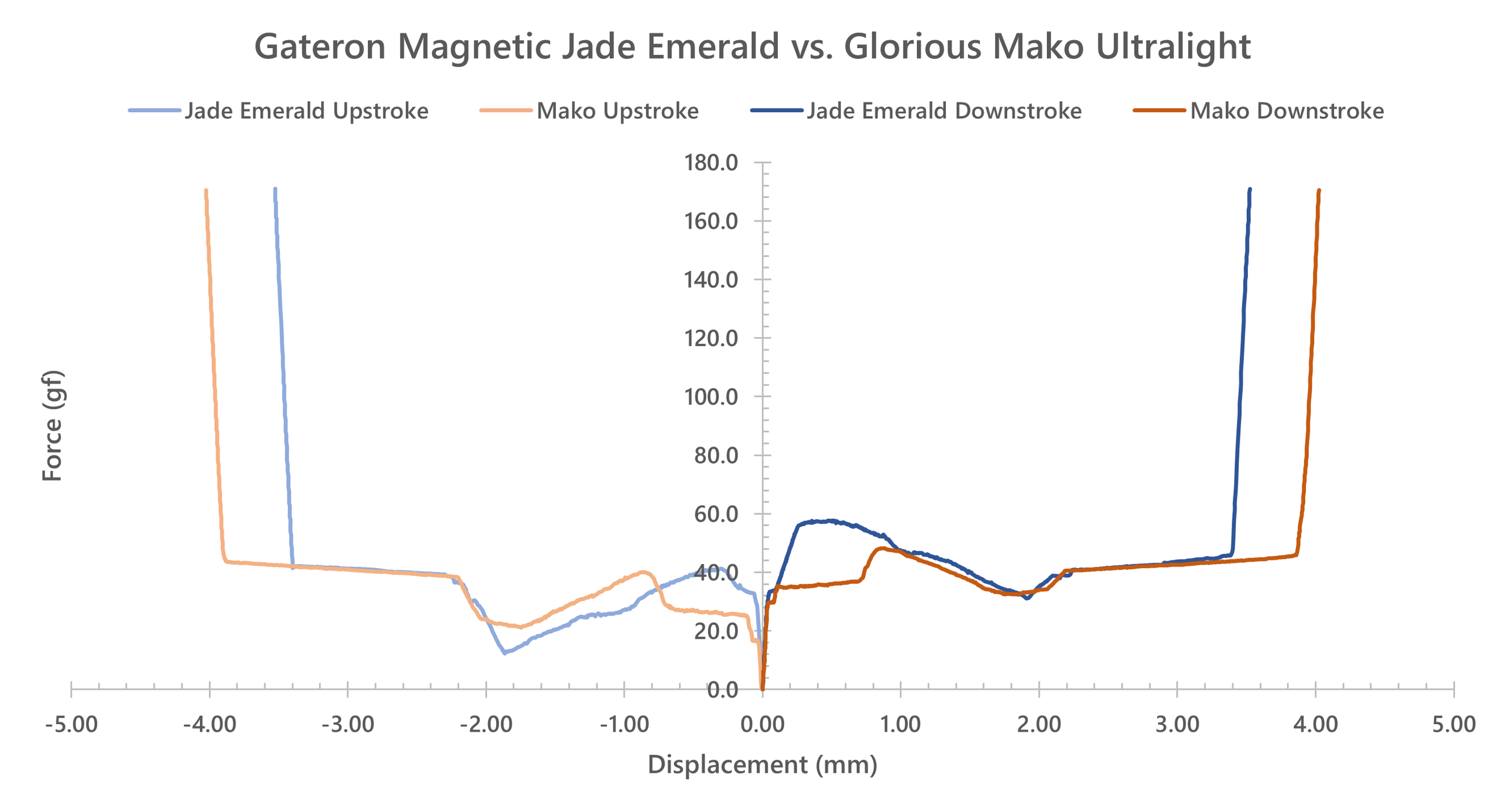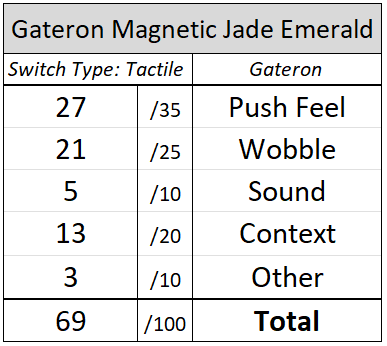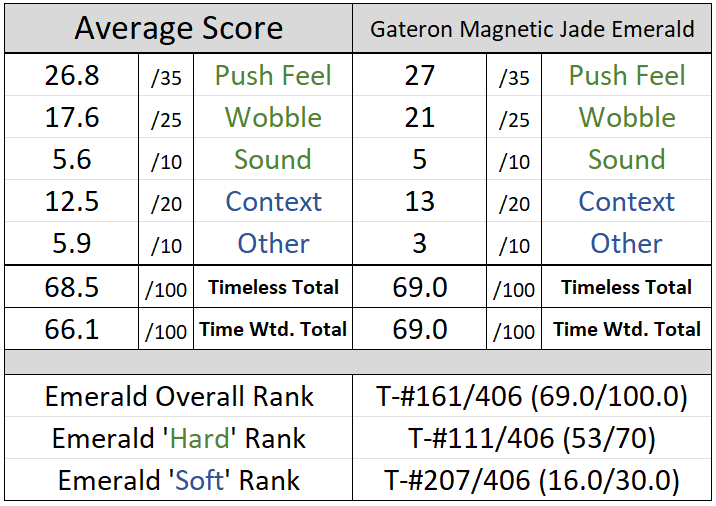Gateron Magnetic Jade Emerald Switch Review
Note: I had every intention of reviewing these switches after having seen the countless ads and social media posts about them from Gateron leading up to Gamescom 2025 and had even queued them up in a cart to purchase when Gateron reached out to me about their release. Thankfully, they were kind enough to send me these as well as some Gateron Magnetic Spark switches on the house since I had said I was planning to order them anyways. It should be noted that they in turn made no requests of reviews from me about these switches and received zero input into or advanced notice of the review posted here or any of its contents. Everything written here, as long winded as it most certainly is, is strictly my opinion and my opinion alone.
For those of you who don’t follow me over on Instagram or Twitter, there was a somewhat comical series of events that took place between this review and the last one that you definitely would enjoy laughing at. After having opened the Cherry MX Honey Switch Review with a short introduction about my recent bird banding operation volunteering and subsequent run ins that I’ve had with one particularly nippy red-eyed vireo, barely a week later a package landed at my doorstep from Cherry featuring none other than a literal stuffed falcon delivering a bag of Cherry MX Falcons to me. While it’s almost certain that this was just a series of well timed coincidences on all of our parts, I’m choosing to internalize this as a sign that companies like Cherry with marketing budgets are in fact reading my reviews intently to try and sway me with personally relevant merchandise. As a result, I feel a strange, unconnected urge to mention that I am also deeply interested in cooking, food, and buying lots of very expensive equipment for my kitchen when I’m not being bitten by birds or writing about switches. Believe it or not I do actually have a genuine degree of pride in the food that I make and I aim to have at least two, if not three sets of meals prepped for the workweek that are about as scratch as possible. While I have yet to start making my own pasta on a regular basis and am a bit here and there with my desire to make various types of bread, everything else is fair game for me to try and go as over the top as possible. Just this last handful of months alone has racked up homemade chili, barbecue pulled pork with twice baked potato, chicken cordon bleu pasta bake, loaded cheesy potato soup, apple cider donut holes, pumpkin chocolate chip cookies, and more things that I can’t find photos in my phone of offhand. (Feel free to DM me asking for any of these recipes, by the way.) Most recently I’m also starting down the path of exploring ice cream flavor development due to a recent Ninja Creami acquisition and an immediate box opening to make a bourbon, peach, and Biscoff flavored concoction that I ate with an equally fervent pace. All of this is to say that I do genuinely love cooking and baking as some of the things that I do in my other free time, and those of you who share some Discord servers with me will occasionally see me post all of this information as well. This totally was not in any way a ploy for someone keyboard switch company out there to send a branded set of professional chefs knives my way or anything. Definitely not that.
Figure 1: The Chocolate Dipped Nixie April Fools article wasn't entirely conceived out of thin air after all…
Switch Background
Over the last handful of years, there’s been quite a large amount of innovation in the mechanical keyboard switch scene, and so much so in fact that using this claim as the start to one of my background sections is starting to become a tad trite. Since I would then normally follow up this claim by pointing to some specific subset of switches that fit x, y, or z theme of the review background that I’m trying to circle in towards, I want to point you all this time in the direction of the truly bizarre. When companies try their hardest to differentiate themselves from the rest of the market, they tend to go all out, though in different ways depending on their outlooks – some choose to strive for perfection in singular types of switch offerings, whereas others will flood the market with as many switches as possible to cast the widest audience capturing net. (See Gateron’s recent bevy of Hall Effect style switches released in the past year or so.) Some manufacturers will try and push for innovation at all costs, while others will try to perfect the classics by nailing down the highest quality and cheapest formulations for such. Regardless of the approach chosen, though, sometimes these manufacturers will stumble into an idea that is not just strange or unorthodox, but paradoxical, in a way; A switch design that while maintaining complete technical feasibility and performance in hand just kind of misses or altogether sidesteps some core tenet of the type of switch that they are being pitched as. I kind of think that these Gateron Magnetic Jade Emeralds which have brought us all here fall into this quite rare, odd subset of switches, though without further elaboration on what qualifies as “paradoxical” switch other than that run-on sentence above, I’m not sure I’ll make the most sense. Here’s what I mean when I think of paradoxical switches:
The Silenced Clicky Switches
Figure 2: The epitome of paradoxical switches in the Kailh Box Mute Jades.
The most obvious example of paradoxical switches that I imagine anyone could come with is the exceedingly rare subset of silenced (or partially silenced) clickies. A clicky switch that has its core, driving purpose of making audible sound neutered in such as a way to have produce instead not quite that same sound? No audible sound at all? Some audible sound? This idea has been taken to varying degrees of extremes over the years with easily the most recognizable being that of the Kailh Box Mute Jades which used dampening pads surrounding their click bar mechanism to effectively deaden sound at the point of triggering instead of allowing for the loud, crystalline clear clicking sound distinctive of the mechanism. A lesser known but also somewhat confusing variant of the silent clicky genre is that of the TTC Brother switches. Choosing to isolate the sound profile of these switches to just their click jacket noise as opposed to letting it all hang out there like the classic Cherry MX Blue, the Brother switches have dampeners at the bottom of their center pole hole to eliminate bottom out noise altogether, leading to a sound profile that is still definitely clicky but lacking a touch of depth that the housing collisions would otherwise provide. While there’s plenty of merit in arguing that both of these switches were successful in their own rights and achieved what they aimed to set out to do, their aims still do feel fundamentally a bit at odds with what the platform they set out to achieve it on. I suppose the logic behind the Brothers could also be applied to generally all semi-silent switches like the JWICK Semi-Silents, TTC Bluish White, and some original Old Tom switches, though those at least aren’t switches initially intended to make a ton of noise in the first place.
The Linear Only Clicky Switch
Figure 3: A clicky switch truly like no other: The Novelkeys Cream Clickie.
Tightening the definition of ‘paradoxical switches’ back up again to just the partially silenced clicky switches, strong modifications of sound profiles is not the only place where antithetical design shenanigans have been employed in clicky switches over the years. Looking instead towards the under-finger feeling of the switch instead of its sound, one of the core aspects of clicky switch designs throughout eternity is that there has to be some mechanism that you push through or into in order for the switch to make a noise. A click jacket, click bar, click leaf, or any vague noise making machinery that you have to engage and put substantial energy into in order to produce noise is present in virtually all clicky switches, with that energy being sufficient enough to also alter the trajectory of their force curves away from one of a purely linear stroke. That is except for the Novelkeys Cream Clickie switches. Unlike all of those clicky switches which came before them, the Cream Clickies were special in that they both employed a new “click plate” style of mechanism as well as placed its main driving force directly in the up and down path of the stem itself. As a result of this, this thin, slightly bowed metal plate would slowly bend under the force of the stem being pushed in until it snapped from ever so slightly concave to convex (or back) and made a metallic clicking noise that is very distinctively present in the ears but not hardly at all under the fingertips. With the force being directly in line with the stem being pushed up or down, it resulted in the feeling to the switch being no different than one with a slightly inconsistent spring; all other clicky mechanisms always had outcroppings or non-vertically oriented mechanisms which induced lateral forces onto the stems instead. As a result the Cream Clickie switches feel like a clicky that is not only truly linear, but one in which you get all of the reward of a clicking sound without hardly any extra effort at all. Just imagine the paradoxical intersections if they chose to randomly partially silence a switch like this one too!
The Double Actuating Switch
Figure 4: Kailh's MK Dose switches with twice the leaves, twice the stem legs, and... four times the fun?
The vintage keyboard enthusiasts among my readers are probably a tiny bit annoyed at me for including the double actuation switch as a type of one that is “paradoxical”. Much more commonplace historically than contemporaneously, double actuation switches have been used a handful of times over in classic keyboard designs for multi-function button presses on terminals or even locking mechanisms for CAPS LOCK keys depending on your precise interpretation of the word “double actuation”. And yet, these types of switches are virtually non-existent in the modern, MX-style switch landscape. I’m not even sure most people would be aware of these types of switches to then be meta-level aware of their absence from the current scene. In fact, modern MX-style switch designs are so precisely over-engineered and designed that if a switch were to ever actually start double actuating of its own accord people would just assume it to be a defect, rip it out of their board, and replace them altogether. The modern idea of a switch which double actuates is one that is ultimately “defective”… and yet Kailh managed to return this idea to a functional state with their MK Dose switches. Included as pre-installed switches in only the MK Duo keyboards, these switches make use of specifically programmed PCBs with tunable settings and a very strange looking internal physical design to achieve four different types of responses depending on how the switch is pressed and what mode it is under. Consider that this means that these switches are taking what used to be 2x functionality that is now considered a -1x functionality and turned it on its head entirely into a 4x functionality with nothing but some fancy engineering work. Mathematical comparisons of functionality notwithstanding, the internal design of the MK Dose switches are the hardest parts of them to make sense of as they appear like the canonical semi-humanoid aliens of the switch world with not just two different sets of leaves but stems that look like a genetic mutation of one stem fused to another. If a switch doing four different variations of a thing that you’re actively fighting to prevent all of your other switches from doing over their 50- to 100-million stroke lifespan isn’t paradoxical, I’m not entirely sure what would be.
And so this returns us back to the Gateron Magnetic Jade Emerald switches with a mental stage fully set to introduce why even these ostensibly simple tactile switches are actually fundamentally paradoxical in their implementation. While these switches certainly don’t seem to engage in the same sort of physical chopping and screwing required to make strange combinations as seen above, their paradox lies in the intersection of their tactile and Hall Effect natures. Traditionally, MX style tactile switches achieve tactility through the use of curved designs on their stem legs that interface with the leaves, modulating inwards and outwards throughout the downstroke of the switch to produce a similarly varying amount of force on the stems themselves. Since the leaves of the traditional MX platform are also what dictate the actuation points of the switch, with them not registering a keystroke until the stem legs are fully pushed through them and the small and large leaves can come together, they can’t have an actuation point that is present before the tactile bump of the switch is fully completed. All MX-style tactile switches have tactile bumps that are completed prior to their point of actuation. As for Hall Effect/magnetic style switches, though, one of their hallmarks in design is the infinite ability to tune their actuation point. Through just changing the amount of magnetic force that is considered as being “on” through software linked in an HE-compatible PCB, users can effectively make it so that a stem pressed in only 10% of the way reads as a complete keystroke just as much as one pressed in some arbitrary amount like 84% of the way down instead. At the intersection of these two natures, this means that the Gateron Magnetic Jade Emerald switches can have their actuation points modulated by their firmware to be anywhere in their stroke… including at the peak of their tactile force. Or half-way up it. Or half-way down the tactile bump fall off, for that matter. Despite these switches having a leaf-like structure in these switches that is producing the tactility, their actuation point doesn’t have to come strictly after the tactile bump is completed. I’m not sure just how many people will outwardly recognize how odd this is because the idea of actuation points being after tactile bumps is just a fundamental assumption of how tactile switches are. Using the HE actuation point switching technology, the Gateron Magnetic Jade Emerald switches are tactiles that could paradoxically be actuated without ever having to even engage with the tactile part of their stroke. A tactile switch that wouldn’t even need to provide tactile feedback at all to be a usable switch while still being fully tactile.
Figure 5: The virgin, MX-bound actuation point versus the Chad Hall Effect actuation range.
With people having asked for this intersection in switch type and mechanism quite a bit in recent months as well as Gateron’s flurry of releases of as many magnetic switches as they possibly could put out, I’m not entirely just how many people inside or outside of Gateron have considered just how odd these switches are on the surface. Nonetheless, the Magnetic Jade Emerald switches have garnered a solid amount of community attention online spurned on by dozens of marketing posts and as many samples sent out to content creators since these switches were first debuted back on August 9th, 2025. Paralleling the equally as large marketing campaign with the Gateron Spark switches, the Magnetic Jade Emeralds were seemingly the centerpiece of Gateron’s Gamescom 2025 convention booth and are even still being posted about in marketing for the 2025 Hong Kong Global Source Shows less than a week before the posting of this review. Made available to the larger public some unknown number of days after their August 9th social media reveal, these switches were first sold on Gateron’s storefront in 70- and 90-count packaging at $59.50 and $76.50 price points, respectively, or a rather steep $0.85 per switch. While far from the most expensive Gateron-made switches which have ever been sold prior, a distinction that still firmly belongs to the Zeal 3-in-1 Clickiez switches, it is certainly a step higher than their conventional MX-style switch releases and is in line with their more recent premium HE switch pricing. As of writing the Magnetic Jade Emeralds are also available through a few other storefronts such as Unikeys and Divinikey at similar price points, though it is uncertain as to what all companies will ultimately sell these as Gateron HE switches have seemingly had mixed availability across all western vendors. Like all things Gateron, I’m infinitely unsure how this availability will continue to be managed as well as how long the Magnetic Jade Emerald switches will be on the market at large. Historically, switches which Gateron puts this much marketing behind tend to stick around for quite some time, though I’m just as convinced that these could be flashes in the pan considering the rate at which they appear to be one-upping their HE switch designs in recent memory. It’s entirely possible that their uniqueness in design could help them indefinitely float along on the market until other manufacturers take on the same paradoxical idea.
Magnetic Jade Emerald Performance
Appearance
At the highest level, the Gateron Magnetic Jade Emerald switches come in a deep translucent green over opaque black color scheme with flat, army green colored stems that don’t quite fit the name of “jade emerald” too well though definitely standout, nonetheless. By direct association with their respective gemstones, the name would seem more fitting in my opinion with lighter, brighter, or even more translucent green colors than the largely opaque color scheme used here. By direct and quite confusing association with other similarly named Gateron Hall Effect switches as of late such as the Magnetic Jades, Magnetic Jade Pros, and Magnetic Jade Maxes, I would have assumed these switches would have been lighter, brighter, and more teal than anything else. Instead these come across as the ostensibly darker, more moody green colored Hall Effect switches of Gateron’s repertoire. Even if not immediately recognizable as being of the HE mechanism instead of the traditional MX one from across the room, I sincerely doubt that these would be mistaken for anything other than Gateron’s new flagship, premium priced HE switches; Kailh’s round box stems haven’t don’t have as square of housing bodies as these and certainly don’t look anything like these or the similarly structured Gateron Magnetic Sparks. Up close, the inverted, newly bubble lettered ‘GATERON’ nameplates mixed with the color scheme would more than eliminate any confusion surrounding the origin of these switches. In fact there are a lot of details in each of these components worth discussing and that make them stand out as interesting in their own respects. These sub-part level details may be found documented in the paragraphs and photos below.
Figure 6: Gateron Magnetic Jade Emerald switches and their components.
Looking first to the deep, vintage Coca-Cola bottle translucent green top housings of the Gateron Magnetic Jade Emeralds, we find an overall shape and design of housing that is unlike anything Gateron has produced before outside of the Emeralds’ linear release sibling in the Gateron Magnetic Spark switches. Featuring a round stem hole, a very lightly arching diffuser bubble over the LED/diode slot, and a ‘GATERON’ nameplate that is stylized to match their newest logo iteration, these don’t look anything like any of the KS-20 or KS-22 Hall Effect switches having been released previously. Unfortunately, though, I’m unable to assign a specific KS-XX number to these switches design as no technical data sheet for these switches nor references to this part code for these switches can be found on Gateron’s website as of the time of writing. Internally the top housings have very little to hide, with the majority of their features crammed to the edges of the housing in order to make space for the incredibly large and wide HE-style stems that Gateron uses in these kinds of switches. Even the mold marking for the Magnetic Jade Emerald top housings is crushed to the side, being found as a single capital letter mold marking on the edge of the lip of the housing near the upper right-hand bottom housing attachment pin instead of its normal spot underneath the nameplate region.
Figure 7: Gateron Magnetic Jade Emerald top housing externals showing inverted, stylized 'GATERON' nameplate, circular stem hole, and very short bubble diffuser over LED/diode region of housing.
Figure 8: Gateron Magnetic Jade Emerald top housing internals showing large gap to accommodate round edged Hall Effect stems and a mold marking on the upper right-hand edge of the housing.
Moving next to the flat, army green colored stems of the Magnetic Jade Emerald switches, we at least find more degrees of overlap with previous Gateron HE switch designs than in either of the housing components. While the Magnetic Jade Emerald switches do not overlap with the dual rail design of the KS-20U Hall Effect switches that Gateron produced, and instead feature non-tapered, flat rectangular slider rails, they do at least inherent the same large gauge round center pole with embedded magnet within it. Featuring no front or back plate to the stems due to the large diameter of the magnet bound center pole, the factory lubing that is present is largely relegated to the sides of the stems both on and adjacent to the slider rails. The most striking part of the design of the stems of the Magnetic Jade Emeralds, though, is their pair of tactile stem legs used to give these switches their classic MX-style tactility. Interestingly this design isn’t as novel as it may appear at first glance when considering that as far back as the Gateron KS-20 switch designs Gateron was placing small outcroppings or mechanism-activating legs in this general regions of the stems, even in such cases where no such mechanism existed like that of the Gateron Dual-Rail Magnetic Orange switches. Perhaps this isn’t as strange of a note when considering that Gateron likely had very little R&D time moving from Hall Effect switch to Hall Effect switch over the recent years. The similarity in design details amongst them would seem to suggest as much.
Figure 9: Gateron Magnetic Jade Emerald stem showing squared off slider rails, large magnet-bound center pole, tactile legs, and trace amounts of factory lubing.
Figure 10: Side profile of the Gateron Magnetic Jade Emerald switches to demonstrate their bump. (Image tilted to make the stem perpendicular to the page.)
Finally arriving to the opaque black bottom housings of the Gateron Magnetic Jade Emerald switches, we’re greeted with an amalgamation of details that all look on the surface correct until one stops to consider the proximity of these components. Viewed through a normal, traditional MX-style switch lens, the housing internals feature a large copper-colored leaf upon which the stem rakes across to produce tactility, non-dampened slider rails, a small amount of white factory lubing that can be seen on said slider rails, and even a wide open LED/diode region for through-switch LED glowing. Viewed through the HE lens, the Magnetic Jade Emerald bottom housings are absent the small MX-style leaf that would be used to help complete the circuit and register keystrokes and also feature a wide diameter large hole to fit the magnet-bound stems. Trying to look through both lenses at the same time as a pair of glasses only reinforces the paradox of these switches as they have ostensibly vestigial parts of the MX design internal and critical to their intended operation. Externally the Magnetic Jade Emerald switches look much more like conventional Gateron HE switches and feature PCB mounting pins, a flat untextured pad for contact with the magnetic sensor in the compatible PCBs, and a small anticounterfeit stamp ‘G’ in the upper left-hand corner of the housing underneath its tactile leaf. Strangely enough, upon closer inspection these housings also feature small, off-gray colored QR codes not dissimilar at all to the Gateorn Magnetic Green Dragon HE switches in their appearance as well as inability to be scanned by any normal phone. Being entirely honest, I almost altogether missed this detail when writing the review and was lucky enough to catch these switches in just the right way in the light as to notice it.
Figure 11: Gateron Magnetic Jade Emerald bottom housing internals showing a large center pole hole for an HE-style stem and one half of a conventional MX-style leaf system.
Figure 12: Gateron Magnetic Jade Emerald bottom housing externals showing PCB mounting pins, 'G' anticounterfeit marking, and an extremely center QR code centered on the bottom of the housing.
Push Feel
In spite of the fact that the Gateron Magnetic Jade Emerald switches rather uniquely tread into the intersection of Hall Effect and tactile switches, the decision by Gateron to use a traditional MX Style leaf mechanism to push tactility into these switches ultimately makes them feel… commonplace, at best. These really don’t stand out as tactiles in any meaningful way compared to anything else present on the market and if I were to have been handed these sans any context I would have considered them to probably just be yet another tactile. However, this is not the only place where expectations of these switches pull up a bit short of the mark. Just shy of snappy feeling at their peak, the early onset of tactile bumps in the Magnetic Jade Emeralds, mixed with their extremely small amount of linear pretravel that is almost 20 gf lower than the tactile bump peak, gives them a feeling that is just tactile enough but hardly in any way “strong”. In fact I wouldn’t even consider these to be medium-strong in force, something which I would have at bare minimum expected given that these switches are technically named as Gateron Magnetic Jade Emerald Heavy switches and listed as such on Gateron’s website. Further driving the wedge between their “heavy” name and their ‘not so heavy’ tactile bump feeling is that of the excessively large, flat, and somehow yet plasticky stem and magnet center pole slamming into the bottom housings with a resounding slap at each bottom out. Due to the sheer size of the contact area between the stems and housings at the end of the stroke, it causes the bottom outs to not only feel drastically heavier than their listed ~46 gf. bottom out force but also so strong as to effectively dwarf the feeling of the tactile bump by comparison. Cycling the Gateron Magnetic Jade Emerald switches all the way through the stroke and surviving the subsequent crash landing that is the bottom out make the tactile bumps feel soft and more Cherry MX Brown-like than the actual tactile bumps feel in isolation. This bottom out’s gravitational pull is even so strong that it nearly completely drowns out what small topping out feeling exists or even the fact that these switches are relatively well lubed and smooth out of the box. (Yes you read that right: the bottom out feeling pulls attention away from the smoothness of the switch here.) In a fighting analogy the combination of the tactile bump and bottom outs of the Gateron Magnetic Jade Emeralds is not just a 1-2 jab to get the opponent moving, but a 1-2 knockout combination with a distracting jab followed up by a wild overhand slam aiming to kill. The only heavy thing about the Magnetic Jade Emeralds is how heavily they laid on the bottom out feeling.
Figure 13: Force curve diagram for the stock Gateron Magnetic Jade Emerald switch.
Sound
The Gateron Magnetic Jade Emerald switches fall back into the classic meme of having a sound profile that more or less aligns with their push feeling notes above, despite Gateron’s best efforts to amalgamate a new to them switch from old concepts. Unlike many other times when I’ve invoked this recurring idea in reviews, though, this one isn’t at all nuanced because the sound profile of the Magnetic Jade Emeralds is simply the bottom out. That’s it. There’s really no noticeable sound from the tactile bumps of the Magnetic Jade Emeralds when typing on them normally, despite them actually having a very subtle and quiet response when isolated on their own. There’s really no sound from the lube-dampened topping outs when typing on the Magnetic Jade Emeralds normally either, despite an ever so slightly snappy punch on return that is just a bit louder than the tactile bump when isolated. It’s just all bottom out, all the way down. When you are typing normally on the Magnetic Jade Emeralds, all you hear is a chorus of metal and sharp plastic stems colliding with the bottom housings in a piercing punch of sound that high in volume, medium-high in pitch, and at least somewhat rounded out in that tone. While I suspect that many users who are fans of conventional clicky switches will enjoy this exact kind of in-your-face sort of sound profile that the Magnetic Jade Emeralds bring, I don’t think that these switches are intentionally being marketed to clicky switch fans at all. Last I recalled, tactile switch fans generally tend to enjoy switches that put all of the emphasis on the tactile bump that they bought the respective switches for, and not really much else. The argument could easily be made that this wouldn’t be true for light tactile fans such as those who use Invokeys’ Blueberry Chiffon switches or more traditionally Cherry MX Browns, though I again think that the marketing escapes them too on account of Magnetic Jade Emeralds being marketed as “heavy” tactiles at best. Resultingly these seem to have a sound profile that wouldn’t be too well enjoyed by heavy tactile fans and also a tactility that wouldn’t be enjoyed by them either. At least I can say that this sound is consistent both across the batch of switches that I received as well as across all of the different typing speeds that I tested them out on. I just suppose I’m not entirely sure who these were designed for – in sound profile especially. It’s just all bottom out all of the time with the sound profiles of the Gateron Magnetic Jade Emeralds.
Wobble
In spite of being designed with Gateron’s “flagship performance zero-drift actuation” stems that have cylindrical housing walls that are marketed as reducing stem wobble, the Magnetic Jade Emeralds have a small amount of equal magnitude N/S and E/W direction stem wobble. This is certainly not enough to likely cause too many issues with too many users, as it is definitely still better than the average keyboard switch out there today, though it is still noticeable and worth pointing out.
Measurements
Figure 14: Numerical details regarding the force curve for the stock Gateron Magnetic Jade Emerald switches.
Have you ever wanted to be bombarded with more switch data than you’ve ever seen at any point in your life before? Consider checking out the ‘Force Curve Repository’ hosted on my GitHub that contains all force curves that I take both within and outside of these full-length reviews. In addition to having these graphs above, I have various other versions of the graphs, raw data, and my processed data all available for over 1500 different switches for you to use however you see fit. Check it out via the ‘Archive’ tab at the top of this page or by clicking any of the force curve cards above.
Break In
Break In Notes
17,000 Actuations
- Through 17,000 actuations, the Gateron Magnetic Jade Emerald switches effectively didn’t change at all. I was not able to pick apart the batch of switches which were broken in to this degree from their stock counterparts on any metric, something which is relatively rare for the break in testing I’ve conducted over the years.
34,000 Actuations
- After 34,000 actuations, the biggest notable change in the Magnetic Jade Emerald switches is a shift in the smoothness of their stroke. Presumably as a result of factory lube migration, the broken in Magnetic Jade Emeralds picked up much more of a ‘sticky’ tone to them that became especially noticeable in the topping and bottoming out of the switches.
- There was also a noticeable but not too substantial increase in both the N/S and E/W direction stem wobbles of the Gateron Magnetic Jade Emerald switches after having been broken in to 34,000 actuations.
51,000 Actuations
- All of the same shifts in performance and sound noted at 34,000 actuations carried over into the batch that were broken in to 51,000 actuations, though with some additional undesired variety in the sound profiles of these switches. This batch appeared to have a much more diverse sounding array of switches than their stock counterparts with a special emphasis on the sticky tones first noted at 34,000 actuations.
Figure 16: Comparative force curve diagram showing no substantial change in the force curves of the Gateron Magnetic Jade Emerald switches throughout the break in process.
Comparison Notes to Other Notable Tactile Switches
Note – These are not aimed at being comprehensive comparisons between all factors of these switches as this would simply be too long for this writeup. These are little notes of interest I generated when comparing these switches to the Gateron Magnetic Jade Emerald switches side by side.
Figure 17: Switches for comparison. (L-R, Top-Bot: Gateron Lanes, Cherry MX Falcon, Sillyworks x Gateron Type R, Akko Cilantro, Drop Holy Panda X, and Glorious Mako Ultralight)
Gateron Lanes
- The Gateron Magnetic Jade Emerald switches have a tiny bit less N/S and E/W direction stem wobble to them than that of the Gateron Lanes.
- Of these two switches, the Gateron Lanes are far and away the more subtle and well balanced sounding tactile switches. Whereas the Magnetic Jade Emeralds have a sound that is loud, aggressive, and fully focused at the point of bottom out, the Lanes are much more balanced and have slightly muted housing collisions that do well to flank and support the subtly snappy sound of their tactile bump.
- The Gateron Magnetic Jade Emerald switches have a tactile bump that on its own feels a fair bit more punchy and strong than the bump of the Gateron Lanes despite what the comparative force curves between these two switches would suggest. I imagine that this is likely due to both the immediacy of the tactile bump in the Magnetic Jade Emeralds as well as the fact that it much more rapidly increases to its peak tactile force than the Lanes.
Cherry MX Falcon
- For once the comparative force curves between a pair of tactiles actually seems correct! The MX Falcons very much do feel like a much more punchy, grown up, and well balanced version of the Magnetic Jade Emerald switches with housing collisions that complement their tactile bump rather than take them over. That being said, though, the factory lubing of the Magnetic Jade Emeralds is still much more clean than that of the MX2A-platform Falcons.
- There is a slight bit less stem wobble in both N/S and E/W directions in the Gateron Magnetic Jade Emerald switches than there is in the Cherry MX Falcons.
- Like all of the other switches on this list, the Cherry MX Falcons are significantly more quiet and subdued in their sound profile than the in-your-face hits of the Magnetic Jade Emerald bottom outs. This is even true through the heavier, more scratchy sounding tactile bump of the MX Falcons.
Sillyworks x Gateron Type R
- Of all of the switches on this comparison list, the Type R switches are in fact the most similar to the Magnetic Jade Emeralds with their general smoothness as well as their strength, size, and placement of their tactile bump.
- The single most distinguishing factor between these two switches is that of their bottom outs. Likely as a result of their larger surface area of contact and differences in materials used at the point of collision (i.e. magnet vs. no magnet), the Magnetic Jade Emeralds are just so much stronger, forceful, and harsh in their bottom out.
- The Type R and Magnetic Jade Emerald switches are also similar in terms of their overall volumes, though their most distinguishing audible feature in their bottom outs is much more different. Whereas the Magnetic Jade Emerald switches are higher pitched and more flat sounding, the Type R bottom outs are more rounded and slightly complex in their tone – something which complements their tactile bump sound much more than the Magnetic Jade Emeralds.
Akko Cilantro
- Despite the similarities in the comparative force curve between these two switches below, the Cilantro switches feel much snappier through their tactile bump and as if they have a full stroke length that is longer than that of the Magnetic Jade Emeralds. This latter phenomenon I’m certain is due to their significantly softer and more subtle bottom out landing than the Magnetic Jade Emeralds.
- The Akko Cilantro switches have noticeably less stem wobble in both N/S and E/W direction than the already better than average Gateron Magnetic Jade Emerald switches.
- Surprisingly, the snappy tone of the Akko Cilantro’s tactile bump is not all that dissimilar from the sound of the Magnetic Jade Emeralds bottom out, though just significantly more subtle, muted, and less aggressive on the ears.
Drop Holy Panda X
- The snappiness of the Drop Holy Panda X’s tactile bump is extremely similar in strength and kick back as that of the aggressive bottom outs of the Gateron Magnetic Jade Emerald switches. The same similarity can also be drawn between the bottom out of the HPX switches and the tactile bump of the Magnetic Jade Emeralds, something which I imagine is as weird to read as it was for me to wrap my head around during testing.
- While the HPX switches have a leathery scratchiness to their tone that is otherwise absent from the Gateron Magnetic Jade Emeralds, these two switches share a similar overall tone and volume, making for rather aggressive switches that people have to really like the sound of in order to tolerate.
- There is a bit less N/S and E/W direction stem wobble in the Drop Holy Panda X switches than there is in the average Gateron Magnetic Jade Emerald switch.
Glorious Mako Ultralight
- Even when drawing the comparison to the tactile bump of the Magnetic Jade Emeralds in the shadow of their aggressive bottom out, the Magnetic Jade Emeralds have tactile bumps that feel larger and more punchy than that of the Glorious Mako Ultralight switches.
- There is quite a bit less N/S and E/W direction variability in the Gateron Magnetic Jade Emerald switches than there is in the Mako Ultralights. As well, it should be noted that the Mako Ultralights suffer from a great degree of batch-wide variability on this metric that is simply missing from the Magnetic Jade Emeralds.
- In spite of the aggressiveness of their bottom out sound, the Magnetic Jade Emerald switches are the much more clean, polished, and cohesive sounding of these two switches on account of just not having any real scratch, ping, or metallic tones that otherwise plague the Mako Ultralights.
Scores and Statistics
Note – These scores are not necessarily completely indicative of the nuanced review above. If you’ve skipped straight to this section, I can only recommend that you at least glance at the other sections above in order to get a stronger idea of my opinion about these switches.
Push Feel
Despite the Gateron Magnetic Jade Emerald switches having no technical flaws in their push feeling like scratch, spring ping, or even cross-batch inconsistency, their “heavy” tactile marketing falls short of experience. When not isolated to themselves, the subtly snappy, early punching medium strength tactile bumps are almost entirely drowned out by an extremely aggressive flat bottom out that just overwhelms the switch’s feeling. While this wouldn’t be bad for any switch marketed on its long pole-first design, that wasn’t even remotely billed here…
Wobble
The Gateron Magnetic Jade Emerald switches have a small but not likely problematic amount of equal magnitude N/S and E/W direction stem wobble.
Sound
Much like the push feeling notes above, the entirety of the sound profile of the Magnetic Jade Emerald switches is their bottom outs. Loud, extremely aggressive on the ears, and punching with a half-plastic, half-metallic sound on account of their stem designs, there’s just nothing else to these switches at all. While it’s hard to really technically fault them on this point, it really does seem to entirely miss all of the marketing of these switches.
Context
Built as part of Gateron’s new premium HE switch line, the Magnetic Jade Emerald switches and their linear release siblings in the Magnetic Spark were marketed endlessly as the future and priced accordingly at the $0.85 per switch mark. While a bit steep here for a concept that feels a bit confused, at the least they’re incredibly well known about and extremely accessible at large.
Other
While I want to give Gateron all the credit for stepping outside of the norm and merging tactile and Hall Effect switches together, this feels like a switch that not only doesn’t live up to its marketing criteria but doesn’t do well to emphasize it’s key features in the slightest.
Statistics
If you are looking at this statistics section and wondering what the heck ‘Timeless’ and ‘Time Weighted’ scoring is, consider checking out my short article titled ‘A Scorecard Time Change’. As a result of scoring becoming a bit anachronistic over the years, switches are now ranked in this statistics table using a “time weighted total” as opposed to their day-of scoring as discussed in that article. If you’d also like to learn about what ‘hard’ versus ‘soft’ ranks refer to specifically, I’d encourage you to head on over to my GitHub linked in the table above or at the links in the top right hand of this website to check out my database of scorecards as well as the ‘Composite Score Sheet’ which has a full listing of the rankings for each and every switch I’ve ranked thus far.
Final Conclusions
One of the inconvenient aspects of publishing written switch reviews instead of live streaming them is that necessarily all of the work is done at some vague point and in some completely undefined fashion before it arrives to you, the reader. As a result, you have no idea what just is editorially coincidental on my part versus something completely planned out from the very start. Even if I do say which way things would land, you should have no reason to believe me. That being said, I swear to you that I had outlined the “paradoxical” connecting theme of these switches in their background prior to ever trying them out and discovering the sheer disconnects between their marketing, their on paper details, and their in hand experience. It was pure serendipity. Billed as heavy tactile Hall Effect switches, the Gateron Magnetic Jade Emeralds are technically proficient, have a clean and well colored appearance, and are in final result exceedingly well executed light tactile switches with a bump strength that is overwhelmed in feeling and sound by an aggressive bottom out instead. While these switches are smooth, you’ll notice their bottom out first. While they do have an early punching, medium-ish strength tactile bump that is decently well rounded, you’ll only notice the bottom out of these switches. And while these switches have < pick some positive feature described above here >, you’ll still notice their bottom outs first. So while these switches completely whiff on porting over strong, heavy MX tactility into the Hall Effect switch platform, you can at least enjoy their HE aspects right? Well, not really. Since the tactile bump of these switches kicks off at the effective start of the downstroke, your ability to select an actuation point before or even during the tactile bump is handicapped by the fact that a switch that only needs to be depressed 10-15% of the way to be actuated is basically unusable for any normal purposes. You almost de facto have to put the actuation point after the tactile bump of these switches - something which is already universal across all MX style tactiles that can’t move their actuation points. If you really wanted to sell the intersection of a selectable actuation point in, on, and around a tactile bump, why wouldn’t you just put the tactile bump in the middle like a conventional lightly tactile switch? The sheer intensity of the Gateron Magnetic Jade Emerald’s bottom outs practically make these tactiles feel like a light tactile switch anyway, so why not let the users enjoy that with a chance to drop an actuation point in the pre-bump linear region, the post-bump linear region, or really anywhere in said tactile bump? I just don’t understand what the Magnetic Jade Emerald switches are trying to be. They’re technically proficient, something which Gateron deserves all the credit in mastering over the years, but they don’t feel like their marketing notes, they don’t feel like they cohesively sell either the HE or tactility aspects they’re predicated on, and they seemingly squander a wide lane to rather complexly approach a neat and relatively unexplored intersection of switch types. I just don’t get it.
Sponsors/Affiliates
Mechbox UK
- A wonderful UK based operation which sells singles to switches that I’ve used above in my comparisons for collectors and the curious alike. Matt has gone out of his way to help me build out big parts of my collection, and buying something using this link supports him as well as my content!
KeebCats UK
- A switch peripheral company based out of the UK which sells everything switch adjacent you could ask for, they’ve been a huge help recently with my film and lube supply for personal builds, and they want to extend that help to you too. Use code ‘GOAT’ for 10% off your order when you check them out!
proto[Typist] Keyboards
- An all-things keyboard vendor based out of the UK, proto[Typist] is a regular stocker of everything from switches to the latest keyboard and keycap groupbuys. While I’ve bought things from the many times in the past, they also are a sponsor of my work and allow me to get some of the great switches I write about!
Divinikey
- Not only do they stock just about everything related to keyboards and switches, but they’re super friendly and ship out pretty quick too. Divinikey has been a huge help to me and my builds over the last year or two of doing reviews and they’ll definitely hook you up. Use code ‘GOAT’ for 5% off your order when you check them out!
ZealPC
- Do they really need any introduction? Zeal and crew kicked off the custom switch scene many years ago with their iconic Zealios switches and the story of switches today couldn’t be told without them. Use code ‘GOAT’ (or click the link above) for 5% off your order when you check them out!
MechMods UK
- A rising vendor based in the UK, Ryan and crew have been a pleasure to work with and have nearly everything you’d need to build your first or fourteenth keyboard. Go build your latest or greatest one right now with them by using code ‘GOAT’ at checkout for a 5% discount!
Dangkeebs
- A longtime supporter of the website and the collection, Dangkeebs has quite possibly the widest variety of switches of any vendor out there. Not only is their switch selection large, but it rotates and is constantly adding new stuff too. You’re going to need 5% off your order with my affiliate to save off the cost of all those switches!
SwitchOddities
- The brainchild of one my most adventurous proxies, SwitchOddities is a place where you can try out all the fancy, strange, and eastern-exclusive switches that I flex on my maildays with. Follow my affiliate code and use code ‘GOAT’ at checkout to save 5% on some of the most interesting switches you’ll ever try!
Cannonkeys
- Does anybody not know of Cannonkeys at this point? One of the largest vendors in North America with keyboards, switches, keycaps, and literally everything you could ever want for a keyboard always in stock and with an incredibly dedicated and loving crew. Follow my affiliate link above in their name to support both them and I when you buy yourself some switches!
Kinetic Labs
- One of the most well-rounded keyboard vendors out there, Christian and crew have been supporters of all my switch and switch-adjacent needs for some years now. I’m honored to have them as an affiliate and think you should check them out using my affiliate link above to support both them and I when you check out their awesome products!
Keebhut
- Want to try out some switch brands that fly under most vendor’s radars? Keebhut is always seeking out that next latest and greatest and has been super helpful in hooking me up with new brands over the past year. They are all about sharing that love as well, and want to give you 5% off your next order with them when you use code ‘GOAT’ at checkout!
Kailh
- No, you’re not mistaken – this is actually that Kailh that manufactures switches. As one of the longest running manufacturers in the hobby, they have a massive variety of switches available over on their website at any point in time. I’m lucky to be affiliated with them now, and so consider using my affiliate link above when ordering some Kailh switches to support me!
Keebz N Cables
- Australia and Oceania’s very own is now a part of the sponsor list here and I couldn’t be happier to add this long time supporter of the collection to it. They’ve always got an amazing selection of switches (and other keyboard parts) in stock and they want to share the love that they’ve shown me with you all too! Use code ‘thegoat’ for 5% off your first order when you visit!
Further Reading
Gateron’s Magnetic Jade Emerald Sales Page
Unikeys’ Gateron Magnetic Jade Emerald Sales Page
Divinikey’s Gateron Magnetic Jade Emerald Sales Page
Milktooth’s Gateron Magnetic Jade Emerald Sales Page
Gateron’s Magnetic Jade Emerald Gamescom Debut Announcement
Gateron Magnetic Jade Emerald Marketing Twitter Post
Gateron Magnetic Jade Emerald Debut Twitter Post
